




BY CINDY WOODEN
VATICAN CITY (CNS) – Parishes and dioceses must move quickly to give life to the consultative bodies and broad participation in mission and ministry already foreseen by church law if the Catholic Church is to have any hope of becoming a more “synodal” church, members of the Synod of Bishops said.
“Without concrete changes in the short term, the vision of a synodal church will not be credible and this will alienate those members of the People of God who have drawn strength and hope from the synodal journey,” the members said in the final document they approved Oct. 26.
Pope Francis convoked the synod in 2021 and called on parishes, dioceses and bishops’ conferences to hold listening sessions before the first synod assembly in Rome in 2023. The current assembly, including most of the same members, began with a Mass at the Vatican Oct. 2.
Members voted on each of the 155 paragraphs of the document, which made suggestions and requests to Pope Francis that included long-term projects, such as continuing discernment about the possibility of women deacons, the need to reform seminary training and the hope that more lay people would be involved in the selection of bishops.
But they also included actions that could and
– Continued on page 6 –
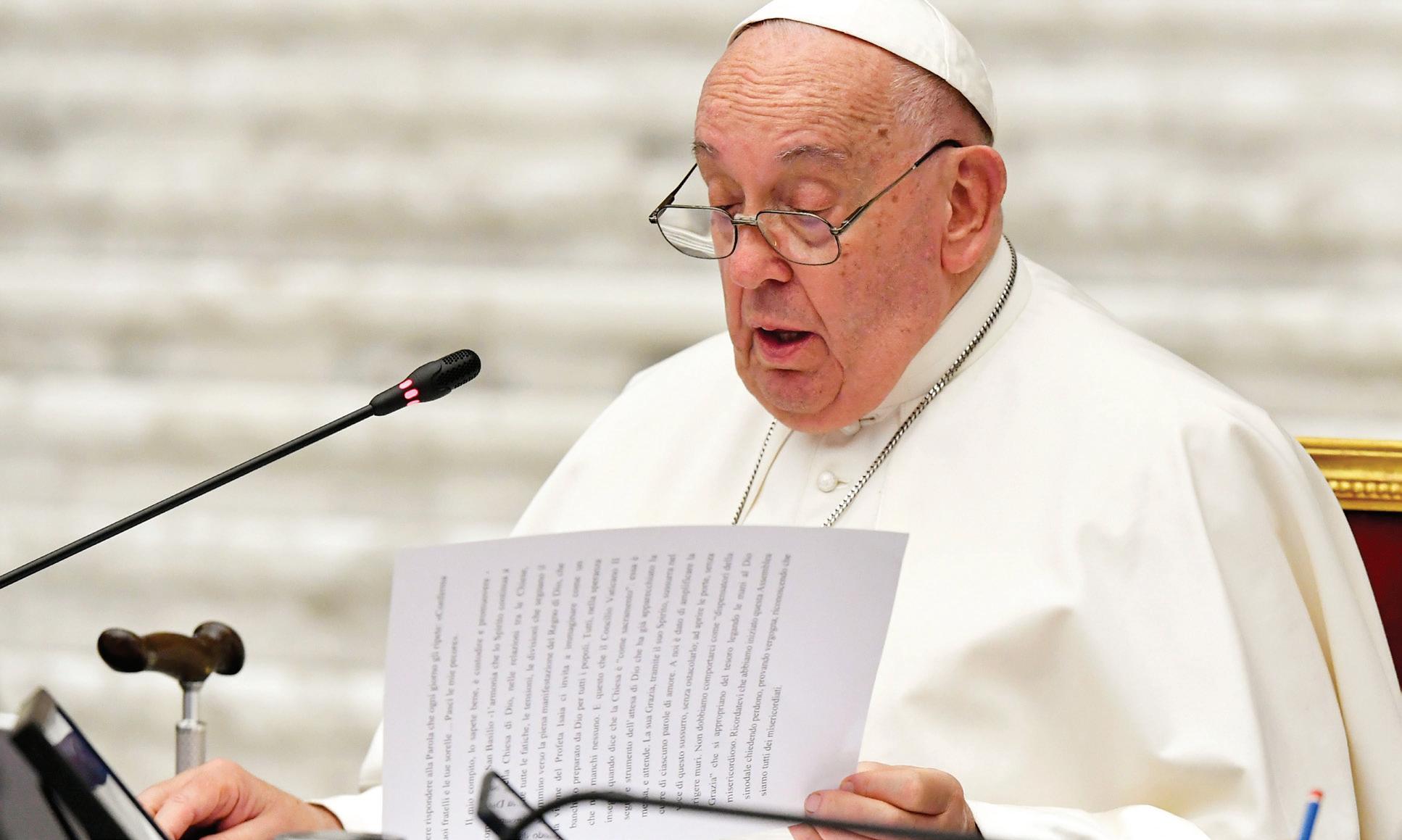
Pope Francis speaks to members of the Synod of Bishops on synodality after they approved their final document Oct. 26, 2024, in the Paul VI Audience Hall at the Vatican. (CNS photo/Vatican Media)
BY JOANNA PUDDISTER KING
MADISON – St. Joseph School has launched its first major capital campaign in 17 years, introducing ambitious plans for new classrooms, a state-of-the-art multipurpose athletic facility, campus-wide upgrades and debt retirement.
The three-year, $5 million “We Are St. Joe” campaign was unveiled before the school’s Homecoming football game on Friday, Sept. 27. This initiative is aimed at strengthening St. Joe’s legacy of academic and athletic excellence while addressing the evolving needs of its students.
“Through the guidance of the Holy Spirit, we are ready to make a big investment in the future of St. Joseph Catholic School,” said Dr. Dena Kinsey, principal of St. Joe. “With the help of our families, alumni and other incredible supporters, this campaign will make a great school even better.”
Dr. Kinsey highlighted the success of St. Joe students across academics, the arts and athletics. “Our
students continue to achieve remarkable things,” she said. “By supporting this campaign, our alumni, friends, families and supporters will help us build on that well into the future. We are 154 years strong and pushing forward.”
In early 2024, St. Joe’s Canonical Board, Advisory Council, and school administration conducted an extensive planning study to identify the school’s immediate and long-term needs. The resulting projects were divided into two phases: the Celebration Goal and the Challenge Goal.
The Celebration Goal aims to raise $2 million to support critical campus upgrades. This phase includes adding two classrooms to the Middle School Building, implementing a new public address system, enhancing HVAC systems campus wide, constructing a retaining wall for the campus lake, and reducing debt on the Fine Arts building.
The Challenge Goal target is to raise an additional $3 million to construct a multipurpose athletic facility. This facility will feature a high-quality floor for volleyball, basketball and cheer, as well as a covered turf field for multi-sport practices and use by the school marching band.
– Continued on page 6 –



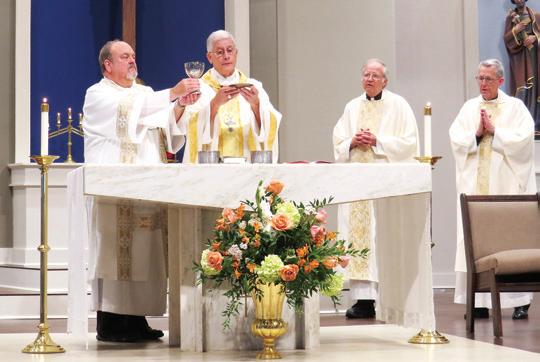

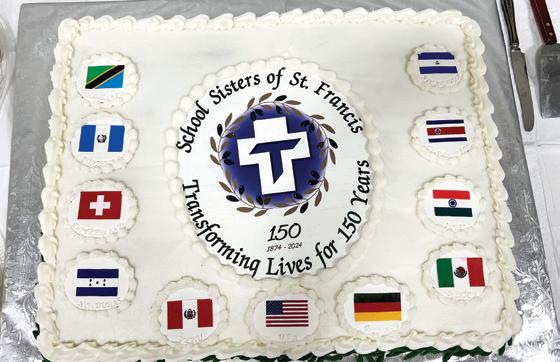



OFFICE OF CATHOLIC EDUCATION – The OCE hosts a Zoom Rosary the first Wednesday of each month during the school year at 7 p.m. On Dec. 4, Annunciation School will lead us in prayer. Join early and place your intentions in the chat. Details: Join the rosary via zoom at https://bit.ly/zoomrosary2024 or check the diocese calendar of events.
PHILADELPHIA, Penn. – Basilica Shrine of the Miraculous Medal, Black Catholic History Month Event featuring Therese Wilson Favors and Ralph Moore on being Black and Catholic (475 E Chelten Ave, Philadelphia, PA) from 12:30-4 p.m. Details: Office for Black Catholics for the Archdiocese of Philadelphia (215) 587-3541.
CLEVELAND – Our Lady of Victories, “Taste of Italy” Lasagna Dinner, Thursday, Nov. 14 from 4:30-7 p.m. Details: church o ce (662) 846-6273.
COLUMBUS – Annunciation School, Open House, Thursday, Nov. 14, 9:45 a.m. to 12 p.m. classrooms open, 8:30 a.m. Mass (optional). Little Eagles Preview at 6 p.m. for PreK-3, PreK and Kindergarten. Details: RSVP to marketing@annunciationcatholicschool.org.
HERNANDO – Holy Spirit, Christmas Program and Dinner, Sunday, Dec. 8. Save the date. Details: Keelan at (601) 604-2202.
MAGEE – St. Stephen, Fall Potluck Lunch, Sunday, Nov. 24. Details: church o ce (601) 849-3237.
MERIDIAN – St. Patrick, Gender and Theology of Your Body hosted by Jason Evert, Wednesday, Nov. 20 from 6-9:15 p.m. Tickets are $15. Proceeds go to the Chastity Project. Details: https://tinyurl.com/ stpatmeridian.
St. Patrick School, Candy Cane Dash, Saturday, Dec. 7 at 8:30 a.m. Register by Nov. 10 to guarantee a shirt. Details: register at https://time2run.raceentry.com/candy-cane-5k-dash/race-information.
St. Patrick, Our Lady’s Corner Christmas Open House, Wednesday, Nov. 13 from 4-6:30 p.m. in the Family Life Center. Come shop for some meaningful Christmas gifts for your friends and family.
St. Patrick, Meridian Catholic Community Thanksgiving Dinner, Sunday, Nov. 17 at 12 p.m. in the Family Life Center. Details: church o ce (601) 693-1321.
NATCHEZ – St. Mary Basilica, Advent Wreath Workshop, Sunday, Dec. 1, in the Family Life Center after 10 a.m. Mass. Families or individuals are invited to come and make an Advent wreath. Fun craft activities available for children. Details: church o ce (601) 445-5616.
NATCHEZ – Wreaths Across America endeavors to honor all veteran’s graves with beautiful wreaths. Home With Heros is the proud, local Miss-Lou partner. Wreath ceremonies take place on Dec. 14 at 9 a.m. at Vidalia Cemetery and 11 a.m. at the Natchez National Military Cemetery. Wreaths cost $17/each. Order yours today at https://bit.ly/3AnaFjs. Details: call Larry at (253) 970-2090.
OLIVE BRANCH – Queen of Peace, Knights of Columbus Spaghetti Dinner Fundraiser, Sunday, Nov. 24 at 11 a.m. Dine in or carry out. Details: church o ce (662) 895-5007.
Queen of Peace, Day of Reflection for Women of the Parish, Wednesday, Nov. 13 beginning at 9:30 a.m. in the social hall. Presentation by Father Guy Blair, SCJ. Details: Bridget at (901) 412-9865.
Queen of Peace, Fellowship Card Night sponsored by the Men’s Club, Friday, Nov. 15

NATCHEZ — St. Mary Basilica parishioners participated in the Procession of the Eucharist following 10 a.m. Mass on Sunday, Oct. 27. The procession is a way to proclaim the belief that Jesus Christ is present in the Eucharist, and to invite others to encounter Him. The St. Mary processional proceeded down Main Street to Wall Street to State Street and back to the church. (Photo courtesy of Natchez Democrat/Jan Griffey)
with dinner at 6 p.m. and games at 7 p.m. cost: $20 per participant for dinner, beverage and 200 chips. All parishioners and guests welcome. Must be 21+. Details: Sign up in the Commons or contact Tracy at lindseyroofing1@gmail.com or (901) 828-4848.
SOUTHAVEN – Christ the King, Advent Program, Sunday, Dec. 1, at 4 p.m. followed by dinner. Details: church o ce (662) 342-1073.
JOB OPENING – The Diocese of Jackson’s Office of Communications is looking for a full-time communications specialist. Role involves creating and promoting content across multimedia platforms, including social media, websites and promotional materials. The position requires strong communication skills, knowledge of Catholic teachings and proficiency in design and communication software. College degree required with two years experience. Send a cover letter and resume to joanna.king@ jacksondiocese.org. If you would like a full job description, visit https://jacksondiocese.org/employment-1.
YOUNG ADULTS – Camino de Santiago Pilgrimage, May 12-27. Father Lincoln Dall will be leading this once in a lifetime journey. Space is limited. Email amelia.rizor@jacksondiocese.org for more information.
YOUTH – Diocesan SEARCH Retreat for tenth through twelfth graders, Jan. 17-19, 2025 at Camp Wesley Pines, Gallman. Diocese High School Confirmation Retreat, Jan. 25-26, 2025 at Lake Forest Ranch, Macon. Diocese Catholic Youth Conference – DCYC for ninth through twelfth grades, March 2123, 2025 at the Vicksburg Convention Center. Details: contact your individual parish o ces or contact Abbey at (601) 949-6934 or abbey.schuhmann@jacksondiocese.org.
CATHOLIC ENGAGED ENCOUNTER – CEE is our diocesan marriage prep program for couples preparing for the sacrament of marriage. The upcoming weekends for 2025 are: Feb. 21-23; August 1-3; and Oct. 24-26at Camp Garaywa in Clinton; and April 25-27 at Lake Tiak-O’Khata in Louisville. Register at https://bit.ly/CEE2024-2025. Details: email debbie. tubertini@jacksondiocese.org.
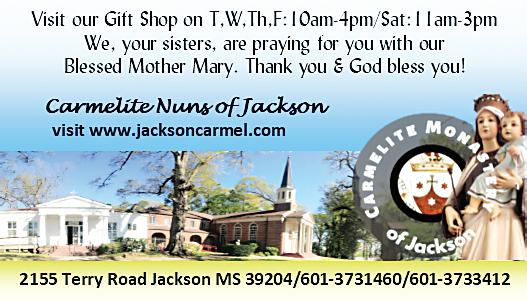
BY BISHOP JOSEPH R. KOPACZ, D.D.
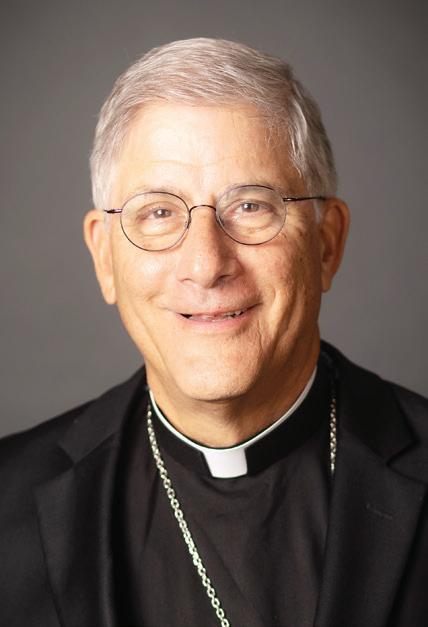
After three years of reflection, the Synod on Synodality came to an end on the evening of Oct. 26, 2024, as the 356 members of the assembly gathered to vote on a final document. In an unexpected act, Pope Francis immediately approved this document, saying that he would not release a post-synodal apostolic exhortation, which is the type of papal document that usually follows a synod. This text thus immediately falls within the Pope’s magisterium. However, he did specify that it was non-normative. Nevertheless, this has been a remarkable pastoral process that brought together the faithful from around the world these past three years.
Led by the Holy Spirit, the conversations began in the local diocesan church and progressed to produce regional and continental documents. The nearly 400 delegates who gathered in Rome during the month of October, last year and this year, represented our One, Holy, Catholic, and Apostolic Church and were
November 10
Deacon Mark White
November 19
Father Jack Kurps, SCJ
November 27
Father Tim Murphy
Thank you for answering the call!





P.O. Box 2130 Jackson, MS 39225-2130
Phone: 601-969-3581 E-mail: editor@jacksondiocese.org
able to build upon the voices of the Catholic faithful from around the world.
At the moment, the Synod document is in Italian, but the wheels of translation are turning to disseminate it far and wide. Not surprisingly, the document does not usher in a new era of church teaching as some were anxious over. But the uniqueness of this Synod is found in the deliberative and consultative gatherings of church leadership that included the ordained, professed, and laity since its inception in 2021.

These substantive encounters brought into the light of day the themes of communion, participation and mission with ample time to take a long and loving look at reality in order to better see, judge and act. This enlarging of the space of our tent in the Body of Christ represented our universality. The photos of the assembled delegates in Rome portrayed this vision whose hard work culminated in the final document. Yet, deliberative and consultative processes cannot be limited to extraordinary processes such as the Synod on Synodality, but ought to be integrated into the life of the church at every level and in every place. Enlarging our vision, sense of mission, and scope of ministries permeates the work of the delegates, and the impact of their labors under the gaze and inspiration of the Holy Spirit will be unpacked, reflected upon, and put into practice for years to come.
Throughout the document there is a repeated call for unity in the Body of Christ, and for a renewed commitment to mission as joyful disciples of the crucified and risen Lord. On Sunday, Oct. 27, the pope presid-
Volume 70 Number 20 (ISSN 1529-1693)

Publisher Bishop Joseph R. Kopacz
Communications Director Joanna Puddister King
Production Manager Tereza Ma
MISSISSIPPI CATHOLIC is an official publication of the Diocese of Jackson, 601-969-1880, 237 E. Amite St., Jackson, MS 39201. Published digitally twice per month January – April and September – December; once per month June, July and August. Mississippi Catholic mails 14 editions per year – twice per month in December and January; and once per month February –November. For address changes, corrections or to join the email list for the digital edition, email: editor@jacksondiocese.org. Subscription rate: $20 a year in Mississippi, $21 out-of-state. Periodical postage at Jackson, MS 39201 and additional entry offices. POSTMASTER: Send address changes to Mississippi Catholic, P.O. Box 2130, Jackson, MS 39225-2130. Website: www.mississippicatholic.com www.jacksondiocese.org
ed over a final Mass for the synod in St. Peter’s Basilica. Surrounded by the summit’s global delegates, Pope Francis encouraged the church to be attentive to “the challenges of our time, the urgency of evangelization and the many wounds that a ict humanity.”
“A sedentary church, that inadvertently withdraws from life and confines itself to the margins of reality, is a church that risks remaining blind and becoming comfortable with its own unease,” said the pope. “If we remain stuck in our blindness, we will continuously fail to grasp the urgency of giving a pastoral response to the many problems of our world.”
As he o cially brought the three-year synod process to its end, Pope Francis declared that it is now time for the church to “get its hands dirty” and “carry the joy of the Gospel through the streets of the world.”
The past three years of world-wide synodality are a beacon of light as we embark upon the Jubilee Year of Hope to begin during the Christmas season and continue throughout 2025. The joy of the Gospel is our gift to the world that cries out in pain for unity and peace.
(Editor’s note: At press time on Nov. 1, 2024, the final document of the XVI Assembly of the Synod of Bishops was only made available in the original Italian. Visit https://www.synod.va/en.html in the coming days for additional language translations.)
Saturday, Nov. 9, 11 a.m. – 75th Anniversary Mass, Holy Family School, Holly Springs
Saturday, Nov. 10, 10 a.m. – 50th Anniversary Celebration and Mass for Deacon Mark White, Queen of Peace, Olive Branch
Nov. 11-15 United States Conference of Catholic Bishops (USCCB) Fall Plenary Assembly, Baltimore, Maryland
Tuesday, Nov. 19 and 26, 7:30 a.m. – Mass, Carmelite Monastery, Jackson
Wednesday, Nov. 20, 8:15 a.m. – School Mass, St. Anthony School, Madison
Thursday, Nov. 21, 8:30 a.m. – School Mass, St. Elizabeth School, Clarksdale
Sunday, Nov. 24, 9 a.m. – Christ the King Feast Day Celebration, Christ the King, Jackson
Sunday, Nov. 24, 5:30 p.m. – Confirmation and OCIA Mass, St. Joseph, Starkville
Tuesday, Nov. 26 – Thanksgiving Meal, Parchman Penitentiary
All events are subject to change. Check with parishes and schools for further details.
Our vocation promotion is about to get super-charged!
On the weekend of Nov. 9-10 every priest in the diocese is being encouraged to share his vocation story at Mass, and every parishioner is being encouraged to submit the name of a man, or men, in their parish, age 15-30, who they think should consider the priesthood. We are calling this effort “Called By Name Weekend,” and I ask that you take part in it!
The names that are brought forth from this program will be catalogued and sent to our vocation team. This is a team of eight priests, including myself, who have committed to running discernment groups throughout the diocese every fall and spring. Depending on where the young man resides, a member of the vocation team will reach out and invite him to consider joining a discernment group and also invite him to other in-person events throughout the year. These events include Come and See weekends at the seminary, dinner with Bishop Kopacz, and more.
Each man who’s name is submitted will also receive a letter from Bishop Kopacz congratulating him for being recognized as someone who takes their faith seriously and encouraging him to be open to these other invitations.
As you consider who you might nominate, please remember, submitting someone’s name does not mean that you know that man is going to be a priest. It simply means that you see a light in him and a desire to do the Lord’s will, and you want to help him get support to discern his vocation. The discernment group that I ran in October had a good mixture of guys. Some were just starting to learn about what the priesthood was all about, while others had been considering the priesthood for a while and were very open to it. All of them got a lot out of the six weeks of group meetings and the social and service outings that were a part of the program. My favorite part was our morning of service when we put together care packages for the homeless and walked around downtown Jackson on a Saturday morning encountering those on the streets. It was really inspiring to see the sincerity of the young men and the courage and care it took for them to speak with the folks that they were serving with compassion and friendship.
We had 36 men in discern-


ment groups this fall, and that was without the help of the Called by Name campaign, so I can’t wait to see what the Lord will do with your help! If you are reading this after Nov. 9-10, but you still want to submit a name, please go to www.jacksonvocations. com/called to submit someone’s name!
– Father Nick Adam, vocation director





By
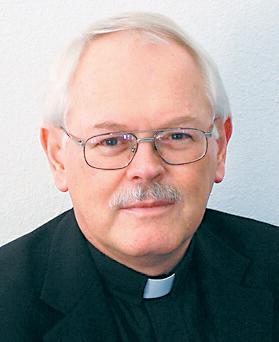
Father ron rolheiser, oMi Creeds ground us. Within a short formula they summarize the main tenets of our faith and keep us mindful of the truths that anchor us.
As a Christian, I pray two creeds, The Apostles’ Creed and The Nicene Creed. But I also pray another creed which grounds me in some deep truths which are not always sufficiently recognized as inherent in our Christian creeds. This creed, given in the Epistle to the Ephesians, is stunningly brief and simply reads: There is one Lord, one faith, one baptism, one God who is Father of us all.
That’s a lot in a few words! This creed, while Christian, takes in all denominations, all faiths, and all sincere persons everywhere. Everyone on the planet can pray this creed because ultimately there is only one Lord, one faith, one baptism, and one God who created and loves us all.
This has far-reaching consequences for how we understand God, other Christian denominations, other faiths, sincere non-believers, and ourselves. There is only one God, no matter our denomination, particular faith, or no explicit faith at all. The one same God is the loving creator and parent of everyone. And that one God has no favorites, doesn’t dislike certain persons, denominations, or faiths, and never disdains goodness or sincerity, no matter their particular religious or secular cloak.
And these are some of the consequences: First, Jesus assures us that God is the author of all that is good. In addition, as Christians we believe that God has certain transcendental attributes, namely, God is one, true, good, and beautiful. If that is true (and how could it be otherwise?), then everything we see in our world that is integral, true, good, or beautiful, whatever its outward label (Roman Catholic, Protestant, Evangelical, Jewish, Hindu, Buddhist, Muslim, New Age, Neo-Pagan, or purely Secular), comes from God and must be honored.
John Muir once challenged Christianity with this question: Why are Christians so reluctant to let animals into their stingy heaven? The creed in the Epistle to the Ephesians asks something similar: Why are Christians so reluctant to let other denominations, other faiths, and good sincere people without explicit faith into our stingy concept of God, Christ, faith, and the church? Why are we afraid of faith fellowship with Christians of other denominations? Why are we afraid of faith fellowship with sincere Jews, Muslims, Hindus, Buddhists, and New Age religious? Why are we afraid of paganism? Why are we afraid of natural sacraments?
There can be good reasons. First, we do need to safeguard precisely the truths expressed in our creeds and not slide into an amorphous syncretism in which everything is relative, where all truths and all religions are equal, and the only dogmatic requirement is that we be nice to each other. Although there is, in fact, something (religious) to be said about being nice to each other, the more important point is that embracing each other in faith fellowship is not saying that all faiths are equal and that one’s particular denomination or faith tradition is unimportant. Rather it is acknowledging (importantly) that, at the end of the day, we are all one family, under one God, and that we need to embrace each other as brothers and sisters. Despite our differences, we all have the same radical creed.
Then too, as Christians, we believe that Christ is the unique mediator between God and ourselves. As Jesus puts it, no one goes to the Father, except through me. If that is true, and as Christians we hold that as dogma, then where does that leave Hindus, Buddhists, Taoists, Jews, Muslims, New Agers, Neo-Pagans, and sincere non-believers? How do they share the kingdom with us Christians since they do not believe in Christ?
As Christians, we have always had answers to that question. The Catholic catechisms of my youth spoke of a “baptism of desire” as a way of entry into the mystery of Christ. Karl Rahner spoke of sincere persons being “anonymous Christians.” Frank de Graeve spoke of a reality he called “Christ-ianity”, as a mystery wider than historical “Christianity”; and Pierre Teilhard de Chardin spoke of Christ as being the final anthropological and cosmological structure within the evolutionary process itself. What all of these are saying is that the mystery of Christ cannot
The Pope’s Corner
be identified simplistically with the historical Christian churches. The mystery of Christ works through the historical Christian churches but also works, and works widely, outside of our churches and outside the circles of explicit faith.
Christ is God and therefore is found wherever anyone is in the presence of oneness, truth, goodness, and beauty. Kenneth Cragg, after many years as a missionary with the Muslims, suggested that it is going to take all the religions of the world to give full expression to the full Christ.
There is one Lord, one faith, one baptism, one God who is Father of us all – and so we should not be so reluctant to let others, not of our own kind, into our stingy heaven.
(Oblate Father Ron Rolheiser is a theologian, teacher and award-winning author. He can be contacted through his website www.ronrolheiser.com.)
Pope to open Holy Door at Rome prison at beginning of Jubilee 2025
By Justin Mclellan
VATICAN CITY (CNS) – Two days after opening the Holy Door of St. Peter’s Basilica to inaugurate the Holy Year 2025, Pope Francis will travel to a Rome prison to open a Holy Door as a “tangible sign of the message of hope” for people in prisons around the world, the Vatican announced.
The pope will go Dec. 26 to Rebibbia prison on the outskirts of Rome, “a symbol of all the prisons dispersed throughout the world,” to deliver a message of hope to prisoners, Archbishop Rino Fisichella, pro-prefect of the Dicastery for Evangelization’s section for new evangelization and the chief organizer of the Holy Year 2025, announced at a news conference Oct. 28.
Pope Francis will open the Holy Door of St. Peter’s Basilica Dec. 24. He will then open the Holy Doors at the major basilicas of St. John Lateran Dec. 29, St. Mary Major Jan. 1 and St. Paul Outside the Walls Jan. 5.
In his “bull of indiction,” the document formally proclaiming the Holy Year 2025, Pope Francis wrote that during the Holy Year he will have close to his heart “prisoners who, deprived of their freedom, feel daily the harshness of detention and its restrictions, lack of affection and, in more than a few cases, lack of respect for their persons.”
In the document, the pope also called on governments to “undertake initiatives aimed at restoring hope” for incarcerated persons during the Holy Year, such as expanding forms of amnesty and social reintegration programs.
Archbishop Fisichella announced that the Vatican had signed an agreement with Italy’s minister of justice and the government commissioner for Rome to implement reintegration programs for incarcerated individuals by involving their participation in activities during the Jubilee Year.
The archbishop also outlined the schedule of cultural offerings leading up to the Jubilee Year, during which the city of Rome estimates that 30 million people will visit the Italian capital.
The Vatican will organize a concert of Shostakovich’s Symphony No. 5, to be performed by the Detroit Symphony Orchestra in Rome Nov. 3; three art exhibitions in November and December, including a display of rare Christian icons from the collection of the Vatican Museums; and a concert from the Sistine Chapel Choir two days before the opening of the Holy Door.
Archbishop Fisichella also unveiled the official mascot of the Holy Year 2025: “Luce” (Italian for light), a cartoon pilgrim dressed in a yellow raincoat, mud-stained boots, wearing a missionary cross and holding a pilgrim’s staff. Luce’s glowing eyes feature the shape of scallop shells, a traditional symbol of pilgrimage and hope.
The mascot, he said, was inspired by the church’s desire “to live even within the pop culture so beloved by our youth.”
“Luce” will also serve as the mascot of the Holy See’s pavilion at Expo 2025, which will take place in Osaka, Japan, from April to October 2025. The Holy See pavilion – which will be hosted inside of Italy’s national pavilion – will have the theme “Beauty brings hope,” and display the 17th-century painting “The Entombment of Christ” by Caravaggio – the only one of his works housed in the Vatican Museums.all.”

“Luce” (Italian for “Light”), the official mascot for the Holy Year 2025, is seen during a news conference at the Vatican Oct. 28, 2024. (CNS photo/Justin McLellan)
– Continued from page 1 –
should be implemented immediately, including hiring more women and laymen to teach in seminaries or having bishops make pastoral councils mandatory for every parish and pastors ensuring those bodies are truly representative of the parish members and that he listens to their advice.
Synod officials said all the paragraphs were approved by the necessary two-thirds of synod members present and voting; 355 members were present and voting, so passage required 237 votes. A paragraph devoted to increasing women’s profile in the church received, by far, the most negative votes of any paragraph with 97 members voting no and 258 voting yes. The paragraph, which required 66% of the votes, passed with 72%.
“In simple and concise terms,” members said, “synodality is a path of spiritual renewal and structural reform that enables the church to be more participatory and missionary, so that it can walk with every man and woman, radiating the light of Christ.”
In a synodal church, the document said, members have different roles, but they work together for the good of all members and for the mission of the church.
Like the synthesis report from the first assembly of the synod in 2023, the final document did not use the term “LGBTQ” or even “homosexuality” and spoke only briefly about the need to reach out to people who “experience the pain of feeling excluded or judged because of their marital situation, identity or sexuality.”
The document repeatedly referred to the “equal dignity” of men and women by virtue of their baptism and insisted the Catholic Church needed to do more to recognize women’s contributions to the life and mission of the church and their potential to offer more.
“Women continue to encounter obstacles in obtaining a fuller recognition of their charisms, vocation and roles in all the various areas of the church’s life,” it said. “This is to the detriment of serving the Church’s shared mission.”
Members of the synod called for the “full implementation of all the opportunities already provided for in Canon Law with regard to the role of women,” and said, “there is no reason or impediment that should prevent women from carrying out leadership roles in the Church. What comes from the Holy Spirit cannot be stopped.”
“Additionally, the question of women’s access to diaconal ministry remains open,” they said. “This discernment needs to continue.”
The question of women deacons was among several questions Pope Francis assigned to study groups last spring. Synod members asked the General Secretariat of the Synod “to continue to watch over the synodal quality of the working method of the study groups,” which are supposed to report to the pope in June.
The synod process, members said, was a “call to joy and renewal of the church in following the Lord, in committing to service of His mission and in searching for ways to be faithful.”
But the document repeatedly acknowledged the crime and sin of clerical sexual abuse and abuse of power, and insisted that a commitment to synodality, particularly to learning to listen and to necessary forms of transparency and accountability, were essential to preventing abuse.
Synodality, members said, “will also help to overcome clericalism, understood as use of power to one’s own advantage and the distortion of the authority of the church which is at the service of the People of God. This expresses itself above all in forms of abuse, be they sexual or economic, the abuse of con-
science and of power, by ministers of the church.”
Lay men and women have many talents that can and should assist bishops and parish priests in the smooth functioning of their dioceses or parishes, synod members said. Tapping into those talents can help bishops and priests, who often feel overworked.
Where church law requires the bishops to consult their priests’ or pastoral council or pastors to consult the parish council, the document said, they “may not act as if the consultation had not taken place.”
“As in any community that lives according to justice,” it said, “the exercise of authority does not consist in an arbitrary imposition of will.”
Synod members also said listening, consulting, praying and discerning before making a decision is not the end of the process. “It must be accompanied and followed by practices of accountability and evaluation in a spirit of transparency inspired by evangelical criteria.”
Ensuring accountability and regularly evaluat-
ing all those who minister in the church’s name “is not a bureaucratic task for its own sake. It is rather a communication effort that proves to be a powerful educational tool for bringing about a change in culture,” synod members said.
One issue that prompted debate during the synod involved the authority of national bishops’ conference, particularly when it came to doctrinal matters.
The synod members, in the final document, called for a study of the theological and juridical status of bishops’ conferences and for a clear definition of “precisely the domain of the doctrinal and disciplinary competence” of the conferences.
(Editor’s note: At press time on Nov. 1, 2024, the final document of the XVI Assembly of the Synod of Bishops was only made available in the original Italian. Visit https://www.synod.va/en.html in the coming days for additional language translations.)
‘ ... St. Joe is ready to keep growing ...’
– Continued from page 1 –
“This is something we have needed for several years,” said Michael Howell, athletic director at St. Joe. “As a member of the MAIS and as our athletic programs grow, we need to provide as much as we can to safely and effectively support and develop our athletes.”
St. Joe’s athletic achievements include 23 varsity sports, while its academic excellence is reflected in a 1-to-12 student-teacher ratio, 12 honors courses, nine AP courses, and an ACT average of 23, and increasing to 26 for students who have been enrolled since seventh grade. The school also offers academic support and dyslexia therapy for students with diagnosed learning needs. Despite being a small school, St. Joe provides a comprehensive education.
“The St. Joe Capital Campaign is a campaign for excellence,” says Bishop Joseph Kopacz. “As culture changes around us, we must continuously search with ‘new eyes and open minds’ the best methods to be ‘distinguished by excellence’ in all areas within the … precepts of the Gospel.”
Bishop Kopacz says that along with school leaders, he is committed to the review and continuous improvement of St. Joe, and all schools and early learning centers throughout the diocese.
“Each of our schools is dependent of the other and each can only reach their full potential when all reach their full potential of being distinguished by excellence,” says Bishop Kopacz.
Now at 154 years strong, St. Joe is ready to keep growing in excellence.
“With this campaign and help from families, alumni and supporters, we will be poised to continue to enjoy success well into the future,” said Dr. Kinsey.
“St. Joe is a great campus and school. This will make it even better.”
Founded in 1870 by the Sisters of Mercy, St. Joseph Catholic School has provided a rigorous, college-preparatory curriculum for students in grades 7 through 12, all grounded in the teachings of the Catholic Church. Located at 308 New Mannsdale Road in Madison, just west of the Interstate 55-Mississippi 463 interchange, St. Joe is accredited by both the Mid-South Association of Independent Schools and Cognia.
(For ways to give to the “We are St. Joe” Capital Campaign visit https://bit.ly/WeAreStJoeCC2024 or contact Candace Sigler at csigler@stjoebruins. com or (601) 898-4800.)

MADISON – This is a rendition of St. Joseph Catholic School’s planned multipurpose athletic facility, one of several projects included in a three-year, $5 million capital campaign called “We Are St. Joe.” Alumni, parents, supporters and friends of St. Joseph School will receive more detailed information, including ways to volunteer and financially support the campaign, in the next few weeks. (Photo courtesy of St. Joseph School)

OLIVE BRANCH – Bishop Joseph Kopacz speaks to Archbishop John Wester of Santa Fe during a live “Q&A” session during the Dehonian Conference on the Dual Threats of Climate Change and Nuclear Weapons that took place between Oct. 7 and 10, 2024. (Photo courtesy of Mary Gorski)
By Mary Gorski
OLIVE BRANCH – Next year the church celebrates the 10th anniversary of Laudato Sí, Pope Francis’ encyclical letter addressed to all people, to “every person living on this planet” to “care for our common home.”
This was the spark that brought approximately 90 people from throughout Canada and the United States to Olive Branch, Mississippi (just south of Memphis), Oct. 7-10, to discuss two seemingly diverse themes: climate change and nuclear weapons. Hosted by the Priests of the Sacred Heart (Dehonians), the “Dehonian Conference on the Dual Threats of Climate Change and Nuclear Weapons,” featured presentations by Archbishop John Wester of Santa Fe and Sister Kathleen Storms, SSND. Participants included Dehonian priests and brothers, coworkers, parishioners, students, seminarians and others with a connection to the religious order, including Bishop Joseph Kopacz, who was present on the first day of the conference and celebrated Mass with participants.
Threats to our “common home”
According to the presenters, two of the greatest threats to our “common home” are climate change and nuclear weapons.
“Climate change is a normal process, but what we are experiencing now is climate disruption,” said Sister Kathleen. “Disruption gets to the roots of our existence; it creates extinction.”
As she spoke, Florida was bracing for Hurricane Milton, the second of two significant hurricanes with devastating impacts in just a few weeks’ time.
“We often look at the environmental crisis and say it will pass,” she continued. “But it is a different kind of crisis right now. It is felt all over the globe. If we don’t care for creation now, we will be in deep trouble.”
An environmental educator, Sister Kathleen Storms had the opportunity to read Laudato Sí prior to it being published. “For me it has given us a new creed of beliefs founded on the ‘Gospel of Creation,’ as expressed in scripture, teachings of the church over the centuries and by numerous popes,” she said. In 2018, on the third anniversary of the encyclical, she
was part of a two-day conference in Rome focused on integral ecology. “A term coined by Pope Francis to speak about the oneness of all creation.”
She urged the Mississippi conference participants to consider an “ecological spiritual conversion,” to reflect on what they can change personally, locally and at an organizational level to better care for our common home.
“What is ours to do?” asked Sister Kathleen. “Our home matters, our creation matters.” And as people of hope, we can work together to bring change. “But it will take every one of us to be the hope needed to make the changes that are necessary.”
Hope is essential
“Hope” may seem an unlikely concept in the midst of presentations on the threats of climate change and nuclear weapons, but it was a word used repeatedly by both of the conference’s presenters.
“Our hope is in Jesus,” said Archbishop John Wester. “We must be people of hope that believe that God will work in us and through us… As Christians, how is the Lord calling me to be an instrument of peace in nuclear disarmament?”
The archbishop was profoundly impacted by a visit to Hiroshima and Nagasaki in 2017. When he returned to Santa Fe, he was acutely aware that much of the work of developing and testing atomic bombs took place in New Mexico. He has since become a staunch advocate for universal, verifiable nuclear disarmament.
In 2022, Archbishop Wester published a pastoral letter titled, “Living in the Light of Christ’s Peace: A Conversation Toward Nuclear Disarmament.”
In the years since, he has continued to keep the issue in the public eye through letters, speeches and regular “pilgrimages of peace” to Japan on the anniversary of the atomic bombings of Hiroshima and Nagasaki.
Via a pre-recorded interview, and a live Q&A through Zoom, Archbishop Wester spoke to the conference about the challenges of disarmament, including arguments for the use of nuclear weapons as a deterrent against aggression.
“I ask, what is better strategy: deterrence or disarmament?” said the archbishop. “If you look at the
danger that nuclear weapons pose, and factor in human nature, tyrants, dictators, terrorism and genuine mistakes, I prefer the strategy of disarmament. Some people may say I am naïve, but I think that the ones who are being naïve are the ones who think that deterrence will work.”
To those who say that deterrence is working, Archbishop Wester insists that “we are simply lucky, and luck is not a good strategy to protect lives… just one Trident submarine has the capacity to destroy all of human civilization. It sounds like hyperbole, but it is not…
“If we care about humanity, if we care about our planet, if we care about the God of peace and human conscience, then we must start a public conversation on these urgent questions and find a new path toward nuclear disarmament.”
More than just words
One of the challenges of any conference is turning it into something more than just an isolated moment in time. In small and large-group discussions, participants identified “next steps” to be taken personally and locally to better care “for our common home.”
Such actions included commitments to live more mindfully, leaving a smaller ecological footprint on the planet, buying locally, and using recyclable materials as much as possible, as well as participants’ commitment to educating themselves on the topics of the conference and having the courage to engage others in discussion of the threats of nuclear weapons and climate disruption, emphasizing that nuclear disarmament is a pro-life issue.
Groups from each region committed to continuing the work of the conference in their ministries; setting dates for future meetings on the local level to ensure that the work of the conference is not easily forgotten. Coworkers talked about working towards paper-free offices, where everything from budgets to publications to province assemblies is done digitally.
The conference concluded with a commissioning ceremony in which participants committed – in writing – to actions that they will do personally at home as a follow-up to the conference.
“My dear brothers and sisters, our gathering here in Mississippi is not on the world stage like the big meetings of heads of state or the United Nations, but believe me, if each of us commits to taking concrete action with the tools we will have at the end of this meeting we will make an impact on the world,” said Father Gustave Lulendo, SCJ, regional superior of Canada, in his words of welcome to the conference.
“Like the leaven of the Gospel, even though it takes such a small quantity to make the dough rise, we will change the lives of our brothers and sisters by influencing the choices they make to preserve our common heritage, this common home that we want to leave to posterity.”
(Mary Gorski is the communications director for the US province of the Priests of the Sacred Heart.)
The Priests of the Sacred Heart is a Catholic religious order of brothers and priests found in over 40 countries around the world. In many they are known as “Dehonians” after their founder, Fr. Leo John Dehon, or by their initials – SCJ – which stands for the official name of the congregation, “Sacerdotum Corde Jesu.” In the United States, the Dehonians have ministries in Texas, South Dakota, Wisconsin and Mississippi, where the order operates two grade schools (Holy Family in Holly Springs and Sacred Heart in Southaven), Sacred Heart Southern Missions, and minister to six parishes in the northern counties of the state.
In response to ‘black mass,’ thousands join Atlanta procession to show devotion to Eucharist
By Andrew nelson
NORCROSS, Ga. (OSV News) –
Traffic came to a standstill along Beaver Ruin Road in the northeast metro area of Atlanta Oct. 25 as Catholics, representing several parishes and speaking multiple languages, followed on foot the Blessed Sacrament as a sign of devotion.
Called “Pilgrims of Hope,” the fall procession’s route linked St. Patrick Church and Holy Vietnamese Martyrs Church in Norcross and Our Lady of Americas Mission, Lilburn, in a prayerful march defending an attack on the participants’ most sacred beliefs. Drivers took photos of the passing event, as organizers handed out rosaries to people stopped in their cars.
Organizers estimated thousands of people took part in the walk.
Ighocha Macokor, 41, a member of the Knights of Columbus at St. Patrick Church said he was walking in his first procession to “stand against evil” and to show the faith to people passing by.
Meanwhile, lawyers working for the Archdiocese of Atlanta received a response from the organizers of a so-called “black mass” scheduled for the same Friday. The organizers confirmed they intended the event as entertainment and possessed no consecrated host.
Concern about the event and its possible sacrilege of a consecrated host prompted the Archdiocese of Atlanta to call for a special day of prayer, reparation and public support for belief in the Eucharist.
Pedro Ulloa and his wife, Flor, and their two grown daughters walked in the thick of the procession. Wearing two crosses around his neck, he said the show of faith allows others to “see the good things about Jesus Christ.”
Faith calls for people to show respect to Jesus, but some choose not to, he told The Georgia Bulletin, Atlanta’s archdiocesan newspaper.
“People can see we want to make a difference,” said Ulloa.
Nancy Frost, a longtime church member, spoke about the black mass event.
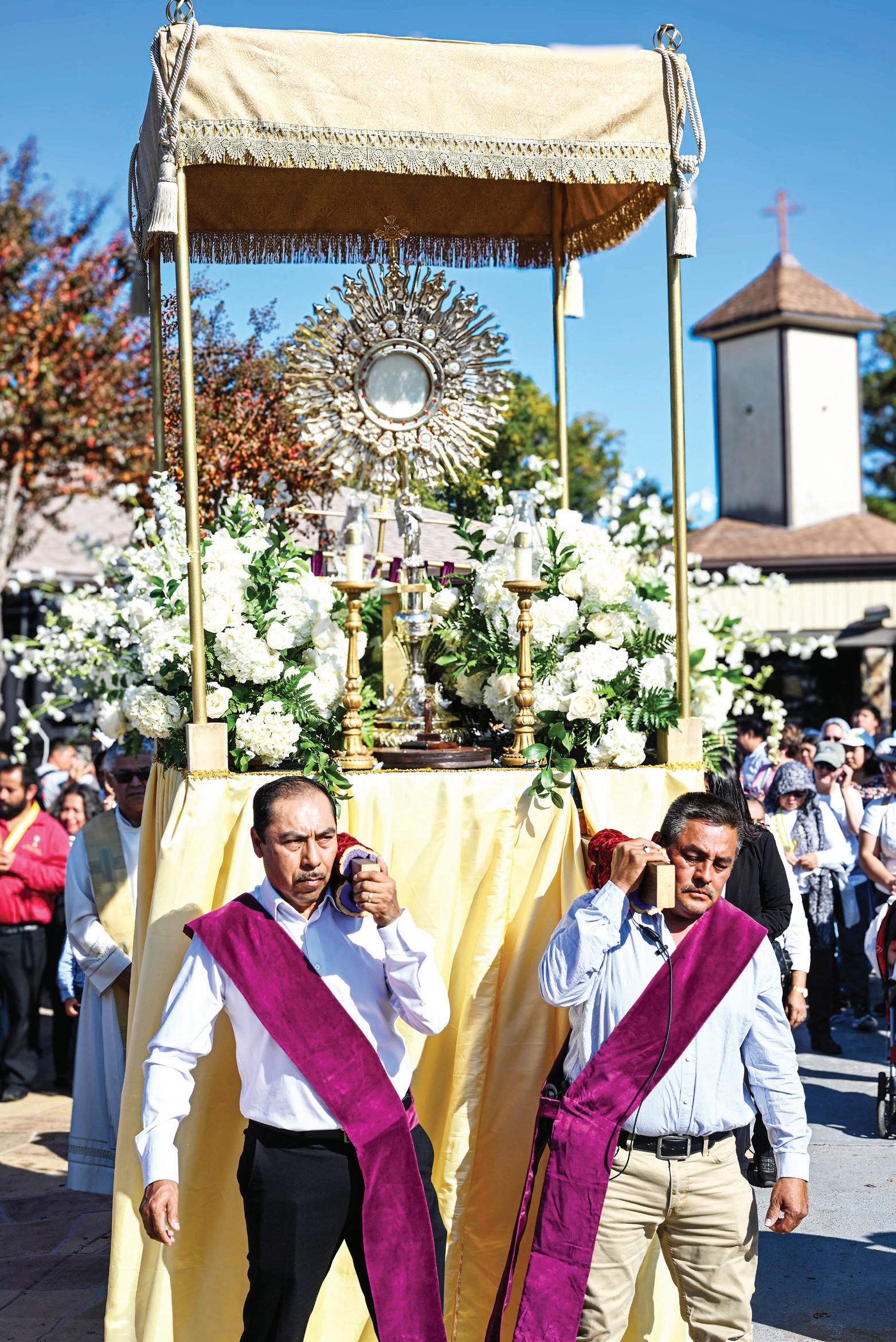
A rotating crew of men and women carry an altar with the Blessed Sacrament Oct. 25, 2024, during the “Pilgrims of Hope” procession along Beaver Ruin Road in Norcross, Ga., in the Archdiocese of Atlanta in response to a satanic group’s planned black mass event (OSV News photo/Andrew Nelson, Georgia Bulletin)
“We can’t have people doing that,” she said about the alleged mistreatment of what the faithful believe to be the body of Christ. “I am proud of the people that we have in our community. It just called to me. There’s no reason I can’t do this. It moves me that this many people are out.”
The procession began at St. Patrick Church, which celebrates Sunday Mass in English, Spanish and Korean, serving a large, diverse congregation. Following the prayers, the believers set out around 3:30 p.m. for a two-hour walk to Holy Vietnamese Martyrs Church.
Under a cloudless sky, the faithful spilled over the narrow sidewalk lining the road, reciting traditional prayers in Spanish and English. Lilburn police escorted the believers along the two-and-a-half-mile route for the first leg of the pilgrimage.
A rotating crew of men and women were pulled from the crowd to shoulder the heavy wooden altar, leaving them with strained and sweaty faces. A large
sunburst monstrance with the exposed Eucharist was surrounded by white flowers and candles.
Loud booms of drums greeted the Eucharist as the participants arrived at the first stop at the Vietnamese church. It was another five miles to the mission destination.
“This shows we are one united church,” said Marissa Anguiano, who works at Our Lady of Americas Mission. She said believers are hurting at the idea of others intentionally desecrating the Eucharist, which Catholics believe is Jesus’ body, soul and divinity.
“We know Jesus is alive and hurting him really brings the community together in prayer,” said Anguiano.
Around the same time that afternoon, Atlanta Archbishop Gregory J. Hartmayer updated the Catholic community on a response. Staff at archdiocesan offices were “overwhelmed with calls, emails and messages of all kinds offering support,” he said. However, the archbishop emphasized that all action from Catholics must be a sign of “love stronger than hate or violence.” He condemned any threats or violence against the venue hosting the event or its organizers.
Lawyers with Smith Gambrell Russell, on behalf of the archdiocese, prepared to take the issue to court to force the return of the Eucharist. A group planning a black mass in Oklahoma returned a stolen host after the diocese there pursued a lawsuit in 2014.
According to the archbishop’s statement, the Satanic Temple of Atlanta responded saying that “they had no such consecrated host, and no such consecrated host would be used in their black mass.” The group’s letter “called their event entertainment and defended their right to express their beliefs by mocking ours,” said the archbishop.
“While their letter continued to mock the Eucharist and our beliefs, it also demonstrated an understanding of how seriously we have taken this threat to our core belief in the Real Presence of Christ in the Eucharist,” he said.
In the end, “while there will always be people who mock and blaspheme Our Lord in the public square,” the archbishop wrote, “we know too, that he will be defended by all of us who love him.”
Archbishop Hartmayer urged “continued prayer both in reparation for all insults to Christ our Lord, but also prayer for those who do not yet know of his love for them.”
“Let us pray for those who turn to darkness. Let us pray that they will come to know that they are welcome in the arms of Jesus; that they will come to experience his true presence and experience true conversion,” he said.
(Andrew Nelson is a staff writer at The Georgia Bulletin, newspaper of the Archdiocese of Atlanta.)
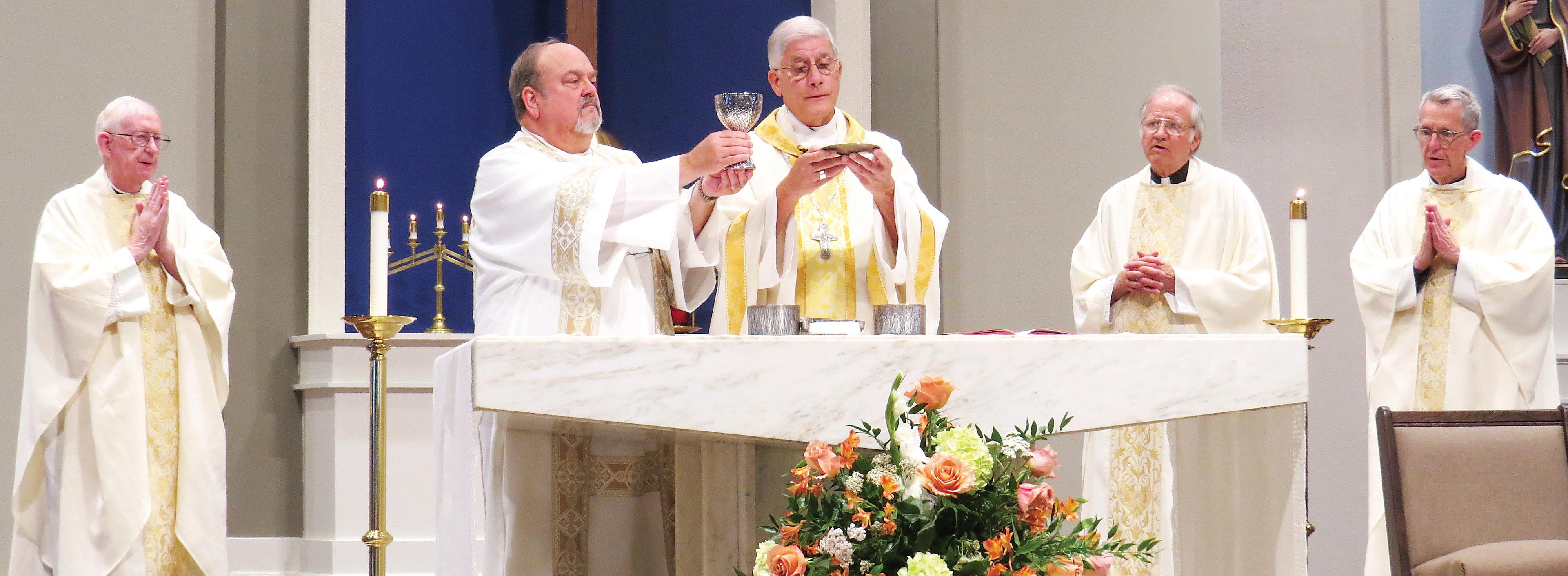
BY JOANNA PUDDISTER KING
CLEVELAND – In 1924, a tiny church building and three-room rectory were built on a lot in Cleveland near the railroad tracks. When it rained in the Delta, the tiny church was described as looking “like it is standing in the middle of a sea,” by accounts from Bishop R.O. Gerow in his diaries. Father Victor Rotondo, pastor in 1924, stated in accounts that the church had no electricity and had to use small birthday candles for light.
Today, Our Lady of Victories Church has grown immensely from its humble beginnings 100 years ago, moving to its final location on the west side of Cleveland in 1976 and with beautiful renovations that took place in 2020-2021.
Parishioners celebrated the 100th anniversary of Our Lady of Victories on Sunday, Oct. 6 with a special Mass with Bishop Joseph Kopacz and Father Kent Bowlds, pastor. Families celebrating the milestone traveled from near and far to reminisce over past parish events and sharing memories of past pastors, including Msgr. Michael Flannery and Father Charles Bucciantini, both present at the celebration.
Bishop Kopacz delivered a homily at the 100th anniversary event commemorating Our Lady of Victories milestone, summing up the rich history of the parish:
“The image of the Lord embracing and blessing the child, and his words demanding conversion of mind and heart to grow in God’s image and likeness describe much of what has taken place at Our Lady of Victories for a century. To welcome, to bless, to forgive in the name of our Lord as his body is the work of the church.
“After reading the history of the parish from many perspectives from the binder that Father Kent sent to my o ce, possibly the first time that I have ever received such a corpus in anticipation of a milestone anniversary, I have a much deeper appreciation for the name of the parish – Our Lady of Victories. I enjoyed the narrative, page by page.
“The parish family has faithfully gathered for worship, education, fellowship and service over the past century and longer, and at key moments have rallied together to overcome setbacks, adversity and obstacles. Under the title and mantle of Our Lady of Victories, the parish remained steadfast in the face of flooding, earthquake and fire. Indeed, you have en-
dured and have compiled numerous victories. …
“We see these realities in the lives of the faithful from the beginning of Our Lady of Victories: courage, mutual support, with hopes and dreams for the parish. This closeness and loving support for one another flow from the heart of God in Jesus Christ for as his body the church. The Lord’s absolute commitment to us, an eternal yes, inspires our commitments in marriage and family, and in the family of the church. …
“Father Rotundo who served for over 20 years was not overwhelmed, and he and the parishioners wasted no time in making the improvements through sweat labor and financial contributions. The courage to begin in that moment set the standard for many critical moments to follow over a century when the members rallied to begin again in successive generations with the second and third church structures, and the numerous accompanying facilities.
“The Word of God today inspires us to appreciate that the courage, beauty and hope that marks Our Lady of Victories’ history in a spirit of closeness, compassion and loving support. These virtues are to be lived daily in the home, as the heart and soul of loving marriages and families. In smaller parish communities there is a closeness among the members, and when the Holy Spirit is driving the bus, families and parish communities flourish as a gift to one another. The parish community has heeded the Lord’s words to “let the children come to me” through the sacraments, baptism, reconciliation, confirmation eucharist, marriage, anointing of the sick, through catechetical formation, and through numerous parish activities. As we heard in the Gospel the Lord wants the church to be a family where God’s children, younger and older are welcomed,
loved, and blessed, and set on the path to eternal life.
“We know that our generation is faced with many challenges in our call to faithfully follow the Lord. With 100 years under your belts, we pray for the courage to begin again at the beginning of this second century for the grace to remain close to the Lord, and with hope that fosters dreams and growth.
“Asking the intercession of our Blessed Mother, Our Lady of Victories, and all the saints let us continue to walk confidently in faith, because our Lord Jesus has given us the ultimate victory in his death and resurrection, he who is Lord forever and ever. Amen.”
(Editor’s note: An anniversary slideshow of parish memories can be found at https://www.olvcleveland. com/anniversary.)
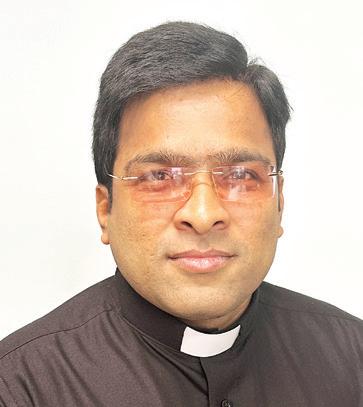
Rev. Joseph Ashok umma appointed Parochial Vicar of St. Mary Parish in Batesville and its mission St. John the Baptist in Sardis; St. Peter Parish in Grenada, and St. John Parish in Charleston, e ective Nov. 1, 2024.
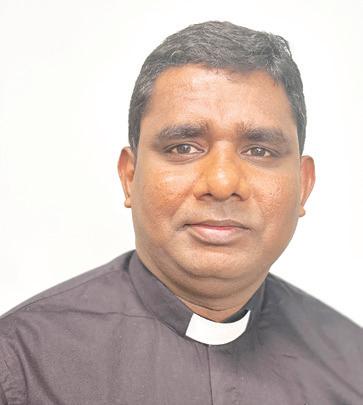
Rev. Joseph Reddy Golamari appointed Parochial Vicar of St. Francis of Assisi Parish in Madison, e ective Nov. 1, 2024.
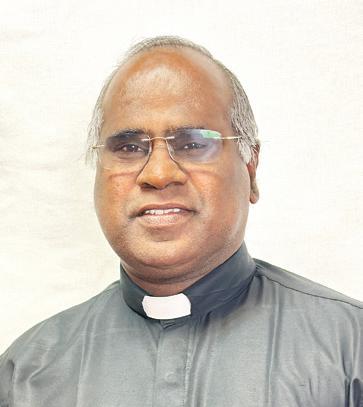
Rev. Gabriel Antonysamy Savarimuthu appointed Parochial Vicar of St. Joseph Parish in Greenville, e ective Nov. 1, 2024.

Diocese of Jackson



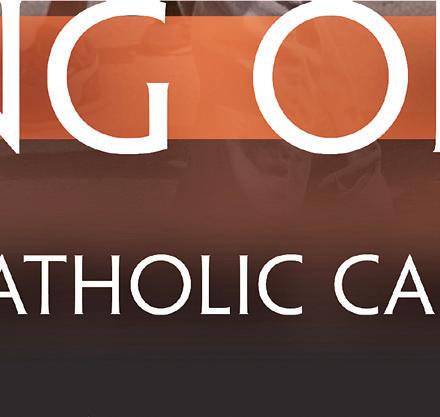


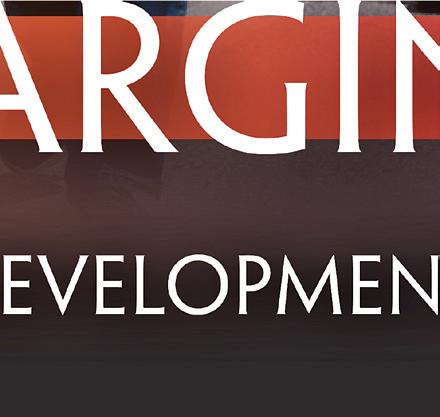

Please be generous, November 16 & 17

8
El Sínodo pide medidas rápidas para implicar a más personas en la vida de la Iglesia
Por cinDy WooDen
CIUDAD DEL VATICANO (CNS) – Las parroquias y las diócesis deben actuar rápidamente para dar vida a los órganos consultivos y a una amplia participación en la misión y el ministerio ya previstos por la ley eclesiástica si la Iglesia Católica ha de tener alguna esperanza de convertirse en una Iglesia más “sinodal”, dijeron los miembros del Sínodo de los Obispos.
“Sin cambios concretos, la visión de una Iglesia sinodal no será creíble y alejará a los miembros del Pueblo de Dios que han recibido aliento y esperanza del camino sinodal”, dijeron los miembros en el documento final que aprobaron el 26 de octubre.
El Papa Francisco convocó el sínodo en 2021, pidiendo a parroquias, diócesis y conferencias episcopales que celebraran sesiones de escucha antes de la primera asamblea sinodal en Roma en 2023. La segunda asamblea que tuvo lugar este año e incluye a la mayoría de los mismos miembros, comenzó con una Misa en el Vaticano el 2 de octubre.
Los miembros votaron sobre cada uno de los 155 párrafos del documento, en el que se hacían sugerencias y solicitudes al Papa Francisco que incluían proyectos a largo plazo, como continuar el discernimiento sobre la posibilidad de mujeres diáconos, la necesidad de reformar la formación en los seminarios y la esperanza de que más laicos participen en la selección de obispos.
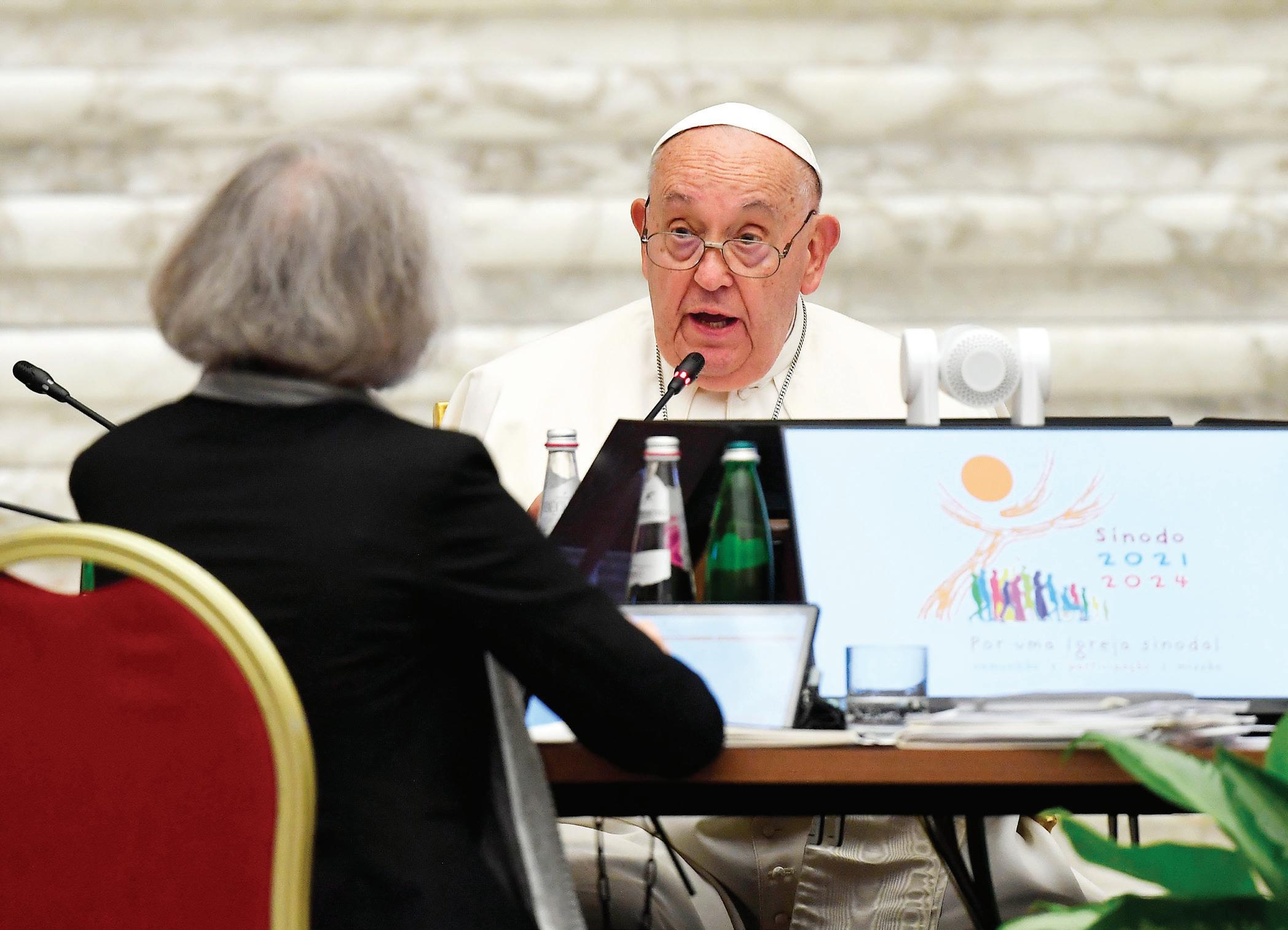
Pero también incluían acciones que podrían y deberían ponerse en práctica inmediatamente, como contratar a más mujeres y laicos para enseñar en los seminarios o hacer que los obispos hagan obligatorios los consejos pastorales en todas las parroquias y que los párrocos se aseguren de que esos órganos sean realmente representativos de los miembros de la parroquia y de que él escucha sus consejos.
Los funcionarios del Sínodo afirmaron que todos los párrafos fueron aprobados por los dos tercios necesarios de los miembros del Sínodo presentes y votantes; 355 miembros estuvieron presentes y votaron, por lo que la aprobación requirió 237 votos. Un párrafo dedicado a aumentar el perfil de la mujer en la Iglesia recibió, con diferencia, el mayor número de votos negativos de todos los párrafos, con 97 miembros que votaron no y 258 que votaron sí. El apartado, que requería el 66 % de los votos, fue aprobado con el 72 %.
“En términos simples y concisos”, dijeron los miembros, “la sinodalidad es un camino de renovación espiritual y de reforma estructural para hacer la Iglesia más participativa y misionera, es decir, para hacerla más capaz de caminar con cada hombre y mujer irradiando la luz de Cristo”.
En una Iglesia sinodal, decía el documento, los miembros tienen funciones diferentes, pero trabajan juntos por el bien de todos los miembros y por la misión de la Iglesia.
Al igual que el informe de síntesis de la primera asamblea del sínodo de 2023, el documento final no
utilizaba el término “LGBTQ” ni siquiera “homosexualidad” y sólo hablaba brevemente de la necesidad de llegar a las personas que “experimentan el dolor de sentirse excluidas o juzgadas a causa de su situación matrimonial, identidad o sexualidad”.
El documento se refería repetidamente a la “igual dignidad” de los hombres y las mujeres en virtud de su bautismo e insistía en que la Iglesia Católica necesitaba hacer más para reconocer las contribuciones de las mujeres a la vida y misión de la Iglesia y su potencial para ofrecer más.
“Las mujeres siguen encontrando obstáculos para obtener un reconocimiento más pleno de sus carismas, de su vocación y de sus funciones en los diversos ámbitos de la vida de la Iglesia”, afirmó. “Esto va en detrimento del servicio a la misión compartida de la Iglesia”.
Los miembros del sínodo pidieron la “plena aplicación de todas las oportunidades ya previstas en la legislación vigente en relación con el papel de la mujer”, y afirmaron que “no hay nada en las mujeres que les impida desempeñar funciones de liderazgo en las Iglesias: lo que viene del Espíritu Santo no debe detenerse”.
“Sigue abierta la cuestión del acceso de las mujeres al ministerio diaconal”, dijeron. “Este discernimiento debe continuar”.
La pregunta sobre el diaconado femenino fue uno de los temas que el Papa Francisco asignó a los grupos de estudio la primavera pasada. Los miembros del Sínodo pidieron a la Secretaría General del Sínodo que siga velando por la calidad sinodal del método de trabajo de los grupos de estudio, que deben informar al Papa en junio de los temas en los que se han enfocado.
El proceso sinodal, decían los miembros, era una “llamada a la alegría y a la renovación del Pueblo de Dios en el seguimiento del Señor y en el compromiso al servicio de su misión y en la búsqueda de caminos de fidelidad”.
Pero el documento reconocía repetidamente el crimen y el pecado del abuso sexual clerical y del abuso de poder, e insistía en que el compromiso con la sinodalidad – en particular con aprender a escuchar y con las formas necesarias de transparencia y responsabilidad – eran esenciales para prevenir los abusos.
La sinodalidad, dijeron los miembros, “ayudará a superar el clericalismo entendido como el uso del poder en beneficio propio y la distorsión de la autoridad de la Iglesia que está al servicio del Pueblo de Dios.
se
especialmente en los abusos
– Continúa en la página 2 –
pobres
Por DaviD agren
CIUDAD DE MÉXICO (OSV News) – El padre Marcelo Pérez, un defensor de los pueblos indígenas que dedicó su vida a la promoción de la paz quien fue asesinado hace unos días, fue enterrado en su tierra natal en medio de indignación y reclamos de justicia.
El padre Pérez, sacerdote de origen tzotzil de la Diócesis de San Cristóbal de las Casas, fue recordado por proteger a los pobres y desposeídos, al tiempo que buscaba el diálogo cuando era posible y denunciaba siempre la injusticia en una región cada vez más violenta.
“El padre Marcelo cuidaba especialmente de los más pobres, de los más débiles, de los más desprotegidos y los cuidaba de la gente abusiva, de la gente poderosa, de la gente que se siente dueña de la sociedad y de la tierra y que no me importa dañar la vida del prójimo para enriquecerse o para adquirir mayor poder político para adquirir todo lo que ellos quieren”, dijo el obispo emérito de Saltillo, José Raúl Vera López, durante una emotiva Misa al aire libre a la que asistieron cientos de pobladores en San Andrés Larrainzar.
“Él se preocupó especialmente de las personas que eran dañadas en su dignidad, en el trato injusto de parte de autoridades o de parte de personas abusivas. Esto, queridas hermanas y queridos Hermanos Es lo que nos dice hoy el Señor Jesucristo”, dijo monseñor Vera, quien era obispo coadjutor en San Cristóbal de las Casas cuando el padre Pérez ingresó al seminario menor.
“Esta es la razón por la que él murió con su palabra de profeta, que es Palabra de Dios”.
Los dolientes en su entierro gritaban: “¡Viva el padre Marcelo!” y “Marcelo, amigo, el pueblo está contigo”.
Pero el impacto de la muerte del padre Pérez golpeó duramente a los habitantes de Chiapas y suscitó la condena generalizada de los católicos de todo el país, así como de muchos miembros de la sociedad mexicana. El padre Pérez había sufrido amenazas e intentos de asesinato por su labor como mediador en conflictos, atendiendo a víctimas de la violencia y enfrentándose a jefes políticos y grupos criminales.
Su asesinato se produjo en una época en que el estado mexicano de Chiapas – el cual ha sido asolado por la pobreza, la desigualdad y la discriminación de los grupos indígenas durante mucho tiempo – se convulsionó por la violencia de los cárteles de la droga, que han hecho huir a cientos de personas a la vecina Guatemala.
El padre Pérez fue asesinado a tiros tras celebrar Misa en San Cristóbal de las Casas el 20 de octubre. Las imágenes de las cámaras de seguridad mostraron al sacerdote saliendo de la iglesia, subiendo a su coche y siendo asesinado a balazos a través de la ventana por un agresor que huyó del lugar.
El gobernador de Chiapas, Rutilio Escandón, anunció el 22 de octubre que se había detenido a un sospechoso. La presidenta Claudia Sheinbaum anunció ese mismo día que la fiscalía federal investigaría el crimen.
Sheibaum, quien asumió el cargo el 1 de octubre, aprovechó su conferencia de prensa matutina del 22 de octubre para destacar la encuesta de “percepción social de Inseguridad” del Instituto Nacional de Estadística y Geografía (INEGI), que mostró una mejor situación de seguridad.
“En el país la gente se siente más segura que en el 2018” – cuando su predecesor y mentor, el presidente Andrés Manuel López Obrador asumió el cargo – e incluso más “que en el 2013”, dijo.
Con referencia a la situación en Chiapas, ella dijo que “es importante trabajar para que no vuelva a ocurrir una situación así y que no haya desplazamientos y pacificar, y evitar extorsiones y delitos que se están presentando”.
La reacción de la presidente reflejó una tendencia del partido gobernante, Morena, a restar importancia a la violencia, incluso cuando ésta se extiende a zonas del país antes consideradas como plácidas.
El padre Pérez, sin embargo, se pronunció sobre la violencia en Chiapas a lo largo de su sacerdocio – y especialmente cuando la violencia se intensificó en ese lugar.
Le dijo a los periodistas que cubrían una marcha por la paz convocada el 13 de septiembre por las tres diócesis católicas de Chiapas que, en muchas comunidades y municipios, la violencia es realmente insoportable.
El padre Pérez nació en San Andrés Larrainzar, un pueblo indígena tzotzil (tsotsil) conocido por los Acuerdos de San Andrés firmados en 1996 por el Ejército Zapatista de Liberación Nacional y el gobierno mexicano tras un levantamiento de los zapatistas por los derechos indígenas.
Ingresó en el seminario menor siendo adolescente y fue ordenado sacerdote en 2002. Era un sacerdote indígena poco frecuente en una diócesis con más de 400 diáconos indígenas casados, que fueron ordenados por el obispo Samuel Ruiz García – que promovió una iglesia autóctona en Chiapas – para atender mejor a comunidades remotas sin sacerdotes.
‘... El Sínodo pide medidas rápidas ...’
ta educativa para provocar un cambio en la cultura”, afirmaron los miembros del sínodo.
sexuales, económicos, de conciencia y de poder por parte de los ministros de la Iglesia”.
Las mujeres y los hombres laicos tienen muchos talentos que pueden y deben ayudar a los obispos y párrocos en el buen funcionamiento de sus diócesis o parroquias, expresaron los miembros del Sínodo. Aprovechar esos talentos puede ayudar a obispos y a sacerdotes, quienes a menudo se sienten sobrecargados de trabajo.
Cuando las leyes de la Iglesia exijan a los obispos que consulten a su consejo sacerdotal o pastoral, o a los párrocos que consulten al consejo parroquial, decía el documento, “no pueden proceder como si no hubiera tenido lugar”.
“Como en cualquier comunidad que vive según la justicia”, decía, “el ejercicio de la autoridad no consiste en la imposición arbitraria de una voluntad”.
Los miembros del Sínodo también dijeron que escuchar, consultar, orar y discernir antes de tomar una decisión no es el final del proceso. “Debe ir acompañado y seguido de prácticas de rendición de cuentas y evaluación en un espíritu de transparencia inspirado en criterios evangélicos”.
Garantizar la rendición de cuentas y la evaluación periódica del desempeño de todos los que ejercen el ministerio en nombre de la Iglesia “no es una tarea burocrática porque sí. Es más bien un esfuerzo comunicativo que se revela como una poderosa herramien-
Un tema que suscitó debate durante el sínodo fue el de la autoridad de las conferencias episcopales nacionales, sobre todo en temas doctrinales.
El padre Pérez sirvió al principio de su sacerdocio en el municipio de Chenalhó, escenario en 1997 de una tristemente célebre masacre en Acteal de un grupo católico pacifista conocido como Las Abejas, que se cobró 45 vidas. Pero después de ocho años en la dividida comunidad, logró la participación comunitaria “sin diferencia de ideología o de postura política en las asambleas litúrgicas y en la forma de formación”, dijo a OSV News el padre jesuita Pedro Arriaga.
Los miembros del Sínodo, en el documento final, pidieron que se estudiara el estatuto teológico y jurídico de las conferencias episcopales y que se definiera con claridad “el ámbito de la competencia doctrinal y disciplinar” de dichas conferencias.
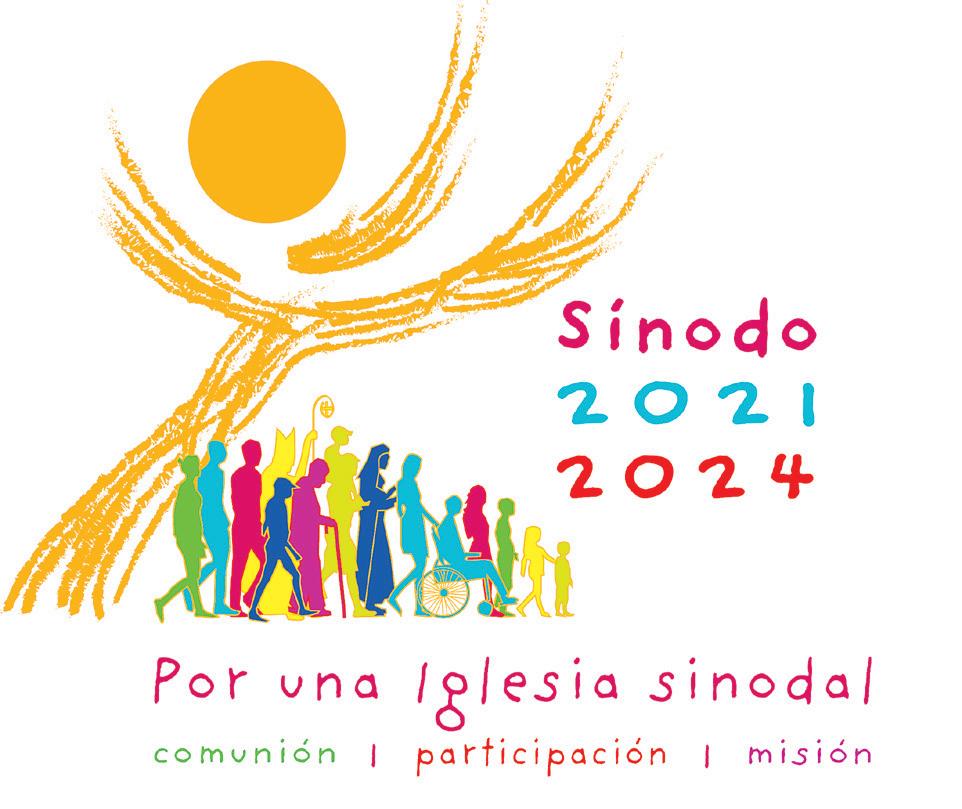
Más tarde trabajó para encontrar la paz durante su siguiente asignación en Pantelhó, donde un grupo armado se sublevó contra un “strongman” local, lo que llevó a que se emitiera una orden de arresto en su contra.
Siempre luchó por la paz, pero no sin riesgos. Unos presuntos asesinos manipularon el sistema eléctrico de su coche para que explotara, pero no funcionó, según el padre Arriaga. En otra ocasión le aflojaron las ruedas. Le instaron a abandonar la diócesis, pero el padre Pérez se negó a huir.
“Había amenazas por tanto tiempo”, dijo el padre Arriaga, antiguo portavoz diocesano en San Cristóbal de las Casas.
Recordó al padre Pérez como “un profeta”, describiéndolo como “siempre del lado de los pobres. Muy radical y sin tener miedo a hacer declaraciones a la prensa”.
“Él consideraba la muerte como una posibilidad por estar denunciando esta situación”.
(David Agren escribe para OSV News desde la Ciudad de México.)
Por obisPo JosePh r. KoPacz, D.D.
Después de tres años de reflexión, el Sínodo sobre la Sinodalidad llegó a su fin en la noche del 26 de octubre de 2024, cuando los 356 miembros de la asamblea se reunieron para votar el documento final. En un acto inesperado, el papa Francisco aprobó inmediatamente este documento, diciendo que no publicaría una exhortación apostólica postsinodal, que es el tipo de documento papal que suele seguir a un sínodo. Por lo tanto, este texto entra inmediatamente dentro del magisterio del Papa. Sin embargo, especificó que no era normativo. Sin embargo, ha sido un proceso pastoral notable que ha reunido a fieles de todo el mundo en estos últimos tres años.
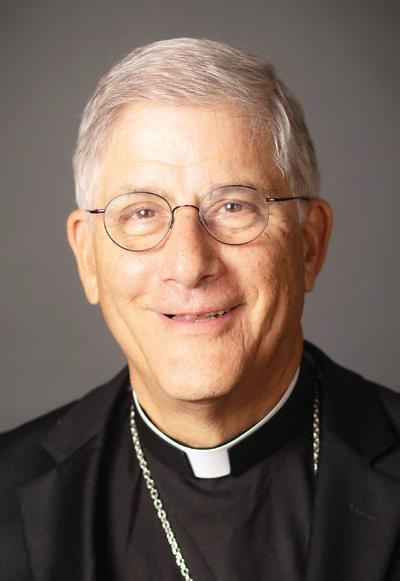
Guiadas por el Espíritu Santo, las conversaciones comenzaron en la iglesia diocesana local y progresaron hasta producir documentos regionales y continentales. Los casi 400 delegados que se reunieron en Roma durante el mes de octubre del año pasado y este año, representando a nuestra Iglesia Una, Santa, Católica y Apostólica y pudieron desarrollar las voces de los fieles católicos de todo el mundo.
Por el momento, el documento sinodal está en italiano, pero el progreso de la traducción está girando para difundirlo a lo grande. No es sorprendente que el documento no marque el comienzo de una nueva era de enseñanza eclesiástica, como algunos estaban ansiosos. Pero la singularidad de este Sínodo se encuentra en las reuniones deliberativas y consultivas de los líderes de la iglesia que incluyeron a los ordenados, profesos y laicos desde su inicio en 2021.
Estos encuentros sustantivos han sacado a la luz los temas de la comunión, de la participación y de la misión, con tiempo suficiente para mirar larga y amorosamente la realidad con el fin de ver, juzgar y actuar mejor. Esta ampliación del el Cuerpo de Cristo representaba nuestra universalidad. Las fotos de los delegados reunidos en Roma retrataron esta visión, cuyo arduo trabajo culminó en el documento final. Sin embargo, los procesos deliberativos y consultivos no pueden limitarse a procesos extraordinarios como el Sínodo sobre la sinodalidad, sino que deben integrarse en la vida de la Iglesia a todos los niveles y en todo lugar. La ampliación de nuestra visión, sentido de misión y alcance de los ministerios impregna el trabajo de los delegados, y el impacto de sus labores bajo la mirada e inspiración del Espíritu Santo será desentrañado, reflexionado y puesto en práctica en los próximos años.
A lo largo del documento hay un llamado repetido a la unidad en el Cuerpo de Cristo, y a un compromiso renovado con la misión como discípulos alegres del Señor crucificado y resucitado. El domingo 27 de octubre, el Papa presidió la misa final del sínodo en la Basílica de San Pedro. Rodeado de los delegados mundiales de la cumbre, el Papa Francisco animó a la Iglesia a ser atentos a “los desafíos de nuestro tiempo, la urgencia de la evangelización y las muchas heridas que afligen a la humanidad”.
“Una Iglesia sedentaria, que se
La Esquina del Papa
retira inadvertidamente de la vida y se confina a los márgenes de la realidad, es una Iglesia que corre el riesgo de permanecer ciega y sentirse cómoda con su propio malestar”, dijo el Papa. “Si nos quedamos atrapados en nuestra ceguera, no lograremos comprender continuamente la urgencia de dar una respuesta pastoral a los muchos problemas de nuestro mundo”.
Al poner fin oficialmente al proceso sinodal de tres años, el Papa Francisco declaró que ahora es el momento de que como Iglesia “pongamos manos a la obra” y “llevemos la alegría del Evangelio por las calles del mundo”.
Los últimos tres años de sinodalidad mundial son un faro de luz a medida que nos embarcamos en el Año Jubilar de la Esperanza que comenzará durante la temporada navideña y continuará a lo largo de 2025. La alegría del Evangelio es nuestro don al mundo que clama con dolor por la unidad y la paz.
(Nota del editor: Al cierre de esta edición, el 1 de noviembre de 2024, el documento final de la XVI Asamblea del Sínodo de los Obispos solo estaba disponible en el original italiano. Visite https://www.synod.va/en.html en los próximos días para obtener traducciones de idiomas adicionales).
Al buscar una vida mejor, los migrantes nos enseñan esperanza y determinación, dice el Papa
by carol glatz
CIUDAD DEL VATICANO (CNS) – Los migrantes demuestran lo que es la esperanza, y la Iglesia católica debe apoyarlos para mantener viva esa esperanza, dijo el Papa Francisco.
“Si queremos que no se pierdan en ellos la fuerza y la resiliencia necesarias para proseguir su viaje, hace falta alguien que se rebaje hasta sus heridas, que se ocupe de su extrema vulnerabilidad física, también (de su) vulnerabilidad espiritual y psicológica”, dijo el Papa a los miembros de los misioneros Scalabrinianos durante una audiencia en el Vaticano el 28 de octubre.
“Se necesitan sólidas intervenciones pastorales de proximidad, a nivel material, religioso y humano, para sostener en ellos la esperanza, y con ella los caminos interiores que conducen a Dios, fiel compañero de viaje”, dijo.
El Papa lamentó “la cerrazón y la hostilidad de los países ricos, que ven en los que llaman a la puerta una amenaza para su propio bienestar”.
“Incluso hoy en día, los que se marchan a menudo lo hacen por las trágicas e injustas desigualdades de oportunidades, de democracia, de futuro, o por los devastadores escenarios bélicos que asolan el planeta”, dijo. Este problema se ve agravado por el cierre de fronteras y la hostilidad mostrada por las naciones más adineradas.
echarlos una vez terminada la cosecha.
La congregación, fundada por San Juan Bautista Scalabrini en 1887, es una comunidad internacional de religiosos al servicio de migrantes y refugiados de diferentes culturas, religiones y etnias en 35 países y en los cinco continentes. Durante el capítulo general de la congregación, el padre scalabriniano Leonir Chiarello fue reelegido a mediados de octubre para otro mandato de seis años como superior general.
El Papa Francisco elogió a la congregación por su trabajo y carisma, diciendo que pensaba en ellos cuando decidió elevar al Colegio Cardenalicio al padre scalabriniano Fabio Baggio, subsecretario y jefe de la sección para migrantes y refugiados en el Dicasterio para el Servicio del Desarrollo Humano Integral. El Papa quiso hacerlo antes, “pero él no quería”, dijo el pontífice. Pero “por obediencia”, el misionero italiano será nombrado cardenal en un consistorio el 7 de diciembre.
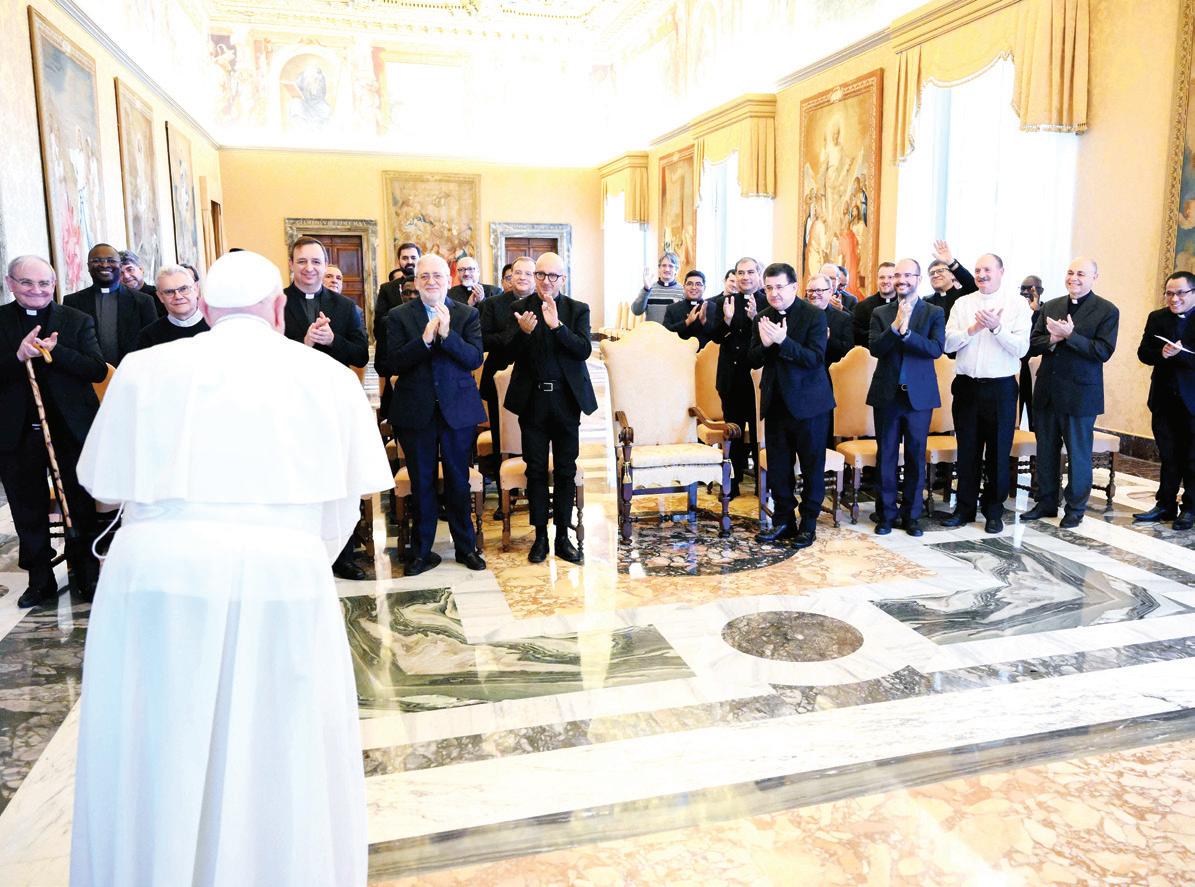
El Papa Francisco se reúne con miembros del capítulo general de los Scalabrinianos en el Vaticano el 28 de octubre de 2024. (Fotos por CNS/Vatican Media)
En este “dramático enfrentamiento entre los intereses de quienes protegen su prosperidad y la lucha de quienes tratan de sobrevivir, huyendo del hambre y la persecución, se pierden tantas vidas, ante la mirada indiferente de quienes se limitan a contemplar el espectáculo, o peor aún, a especular con la piel de los que sufren”, dijo, condenando el “escándalo” de los cultivadores de manzanas del norte de Italia que acogen a migrantes del centro de Europa para
“Tómenlo como un gesto de estima, de gran estima”, dijo el Papa Francisco.
Los emigrantes “son maestros de esperanza”, dijo, destacando cómo siendo hijo de inmigrantes italianos en Argentina, su familia siempre sintió que ir a “América” era una forma de prosperar y tener una vida mejor. “A menudo sostenida por el amor a las familias que dejan atrás”, dijo, la determinación de los que emigran “nos enseña tanto”. La migración puede ser un momento de crecimiento para todos, “con un apoyo adecuado”.
Los migrantes deben ser acogidos, acompañados, apoyados e integrados en las comunidades de acogida, afirmó.
Independientemente de quiénes sean o de dónde vengan, todos los migrantes deben ser vistos como “un don de Dios, único, sagrado, inviolable, precioso para el bien de todos”, dijo.
8 de noviembre de 2024

Una persona camina por una calle inundada el 30 de octubre de 2024, en Llombai, en la región española de Valencia, después de que la agencia meteorológica española pusiera a la región en alerta roja máxima por lluvias extremas. (Fotos por OSV News/Eva Manez, Reuters)
NUEVA YORK (OSV News) – Varias organizaciones están invitando a los fieles a rezar por los cristianos perseguidos durante todo el mes de noviembre, ya que más de 365 millones de creyentes en Cristo en todo el mundo sufren altos niveles de persecución y discriminación, según un informe de 2024 del grupo de defensa Open Doors. El primer y segundo domingo de noviembre (3 y 10 de noviembre) han sido designados como un Día Internacional de Oración por la Iglesia Perseguida, una conmemoración organizada hace unas dos décadas por la Alianza Evangélica Mundial, con sede en Nueva York. Las dos fechas están diseñadas para dar a las comunidades religiosas flexibilidad y comodidad a la hora de observar la ocasión, según el sitio web dedicado a la iniciativa, idop.org. Puertas Abiertas, que proporciona Biblias y apoyo a cristianos perseguidos en más de 70 países, señala que 1 de cada 5 cristianos en África y 2 de cada 5 en Asia sufren persecución. Sólo en el último año, el número de creyentes perseguidos ha aumentado en unos 5 millones, según la organización. El 20 de noviembre, Ayuda a la Iglesia Necesitada – conocida como ACN, es una fundación promovida por el Papa que proporciona ayuda pastoral y humanitaria a los cristianos perseguidos – conmemorará el Miércoles Rojo, establecido por ACN en 2016 para concienciar sobre la persecución cristiana en todo el mundo. En honor a este día, se anima a las parroquias, escuelas y participantes individuales a vestirse de rojo, que recuerda la sangre de los mártires.
CIUDAD DEL VATICANO (CNS) – Dos días después de abrir la Puerta Santa de la Basílica de San Pedro para inaugurar el Año Santo 2025, el Papa Francisco irá a una prisión de Roma para abrir una Puerta Santa como “signo tangible del mensaje de esperanza” para las personas en las cárceles de todo el mundo, anunció el Vaticano. El Papa acudirá el 26 de diciembre a la prisión de Re-
bibbia, en las afueras de Roma, “símbolo de todas las prisiones dispersas por el mundo”, para transmitir un mensaje de esperanza a los presos, anunció el 28 de octubre en rueda de prensa el arzobispo Rino Fisichella, pro-prefecto de la sección para la nueva evangelización del Dicasterio para la Evangelización y principal organizador del Año Santo 2025. El Papa Francisco abrirá la Puerta Santa de la Basílica de San Pedro el 24 de diciembre. A continuación, abrirá las Puertas Santas de las basílicas mayores de San
Juan de Letrán el 29 de diciembre, Santa María la Mayor el 1 de enero y San Pablo Extramuros el 5 de enero.
VALENCIA, España (OSV News) – El arzobispo de Valencia expresó su «grave preocupación» y celebró una misa por los afectados después de que al menos 72 personas murieran y muchas más desaparecieran a causa de las lluvias torrenciales que provocaron inundaciones masivas en el sureste de España. Las inundaciones convirtieron las carreteras en ríos de coches flotantes y cortaron autopistas y accesos, llegando el agua hasta el primer piso de los edificios. El arzobispo Enrique Benavent declaró el 30 de octubre que «espera que las víctimas y los desaparecidos sean encontrados sanos y salvos lo antes posible», según el medio católico español Alfa y Omega. El arzobispo celebró una misa por todos los afectados la mañana del 30 de octubre en una basílica local. En una carta enviada al arzobispo Benavent y a monseñor Julián Ros, administrador apostólico de la diócesis de Albacete, al oeste de Valencia, los obispos españoles dicen que comparten «su dolor por los difíciles momentos que están viviendo en sus diócesis». Las terribles inundaciones que dejaron montones de coches atascados entre los edificios de las históricas y estrechas calles de Valencia y atraparon a decenas de residentes fueron causadas por la tormenta Dana, calificada de «fenómeno sin precedentes» por la ministra de Defensa española, Margarita Robles. El Rey Felipe VI manifestó su «consternación y preocupación» por las inundaciones repentinas. Hablando de la «enorme destrucción» del 30 de octubre, dijo que el acceso a algunas zonas seguía siendo difícil. España declaró tres días de luto tras las inundaciones repentinas que devastaron parte del país.
Vírgenes y Santos
San Martín de Tour. Noviembre 11
Santa Francisca Javiera Cabrini. Noviembre 13
Presentatión de la Bienaventurada Virgen María. Noviembre 21
Día de Acción de Gracias. Noviembre 28
San Andrés, Apóstol. Noviembre 30
Inmaculada Concepción. Diciembre 9
Nuestra Señora de Guadalupe. Diciembre 12
RIPLEY – St. Matthew, visita del Consulado de México, sábado y domingo, 23 y 24 de noviembre. Detalles: stmatthewcatholicchurch@ripleycable. net.
SOUTHAVEN – Christ the King, Programa de Adviento 2024, 1 de diciembre de 2024 a las 4 p.m. seguido de la cena.
Christ the King, Desayuno y oración para hombres en Chick-fil-A Southaven (235 Goodman Rd
W). Todos los miércoles a las 7 a.m. Únase a nosotros para una mañana de oración y compañerismo. Más información con Tom (901) 406-4063. Christ the King, Vacunas Gratuitas Contra la Gripe después de las misas de 11 y 12:30 del domingo 17 de noviembre. Para reservar su vacuna, por favor registrese en el área de reunión este fin de semana.
TUPELO – St. James, Evento familiar de formación de la fe «Me Pregunto», domingo 15 de diciembre a las 10:15 a.m. en Shelton Hall. Detalles: Rhonda at rhondaswita13@gmail.com.
St. James, Taller Creciendo en el Diálogo Espiritual para Ministerios de Música, sábado 16 de noviembre a las 18:30. Cómo mejorar nuestra comunicación de acuerdo con nuestra fe. Detalles: confirma tu asistencia Olga (787) 379-3499.
St. James, Reunion de Parejas, Tema confianza y diálogo en la pareja, 14 de noviembre a las 6:30 p.m. en la Salón María.
Envíenos sus fotos a editor@jacksondiocese.org
Síganos en Facebook: @DiócesisCatólicadeJackson
FORT WORTH, Texas (OSV News) – Members of a women’s religious community in Arlington have been dismissed from the Carmelite order and Catholic religious life, according to Oct. 28 statements from Bishop Michael F. Olson of Fort Worth and Mother Marie of the Incarnation, whom a Vatican o ce appointed as the community’s major superior in April. The bishop and major superior attributed the dismissal to the nuns’ decisions “to break faith with their Mother, the Church of Rome” through denying the authority of the Vatican Dicastery for Institutes of Consecrated Life and Societies of Apostolic Life, their bishop and the dicastery-appointed major superior. The nuns also entered into an unlawful, formal association with the Society of St. Pius X Sept. 14 and soon after illicitly transferred ownership of their Monastery of the Most Holy Trinity to a nonprofit organization of laypeople, the statement notes. The a ected nuns did not immediately respond on their website, which has been their mainstay for public communication over the past 18 months as they have openly feuded with Bishop Olson following his allegations in April 2023 that their community-elected prioress had committed unspecified sins against chastity. The saga has included church and civil courts, the nuns’ public rejection of the bishop’s governance authority over them, and their formal affiliation with the Society of St. Pius X.
LONG BEACH, Calif. (OSV News) – This year’s National Catholic Youth Conference theme “El Camino / The Way,” seeks to resonate with attendees, said Natalie Ibarra, the communications manager for the National Federation for Catholic Youth Ministry, emphasizing the focus is on walking alongside peers and families in faith. The three-day conference, scheduled for Nov. 14-16 in Long Beach, California, is designed for high school students and their chaperones, and provides a central location that is more accessible for West Coast participants. NCYC 2024 will include a variety of engaging activities, including over 20 youth breakout sessions on topics ranging from pro-life activism to vocational discernment. Notable speakers and artists will enhance the experience, while an interactive exhibit hall will allow youth to explore various aspects of Catholic life and ministry. Ibarra noted e orts to reach Latino youth, acknowledging the financial barriers some families face. Organizers stressed that NCYC aims to unite young Catholics from across the country, fostering a sense of belonging and shared faith among participants. Pat Clasby, a parish director of confirmation and youth ministry at St. Patrick Church in Carlsbad, California, who is involved in organizing this year’s NCYC, said the conference will allow youth to see the larger Catholic Church. “It’s an opportunity
for the youth to see other young people from around the country practicing their faith and realize they are not the only ones that are teenagers who are Catholic,” he said. “They are not the only ones trying to live their faith out loud.”
VATICAN CITY (CNS) – Migrants demonstrate what hope is, and the Catholic Church must support them to keep that hope alive, Pope Francis said. “If migrants are to preserve the strength and resilience necessary for them to continue on their journey, they need someone to attend to their wounds and to care for them in their extreme physical, spiritual and psychological vulnerability,” the pope told members of the Scalabrinians during an audience at the Vatican Oct. 28. “E ective pastoral interventions that demonstrate closeness on the material, religious and human levels are required in order to keep their hope alive and to help them advance on their personal journey toward God, their faithful companion on the way,” he said. The pope lamented “the hostility shown by rich countries that perceive those knocking at their door as a threat to their own well-being.” Migrants are to be welcomed, accompanied, supported and integrated in the host communities, he said. Regardless of who they are or where they came from, all immigrants are to be “viewed as a gift of God, unique, sacred, inviolable, a precious resource for the benefit of all,” he said.
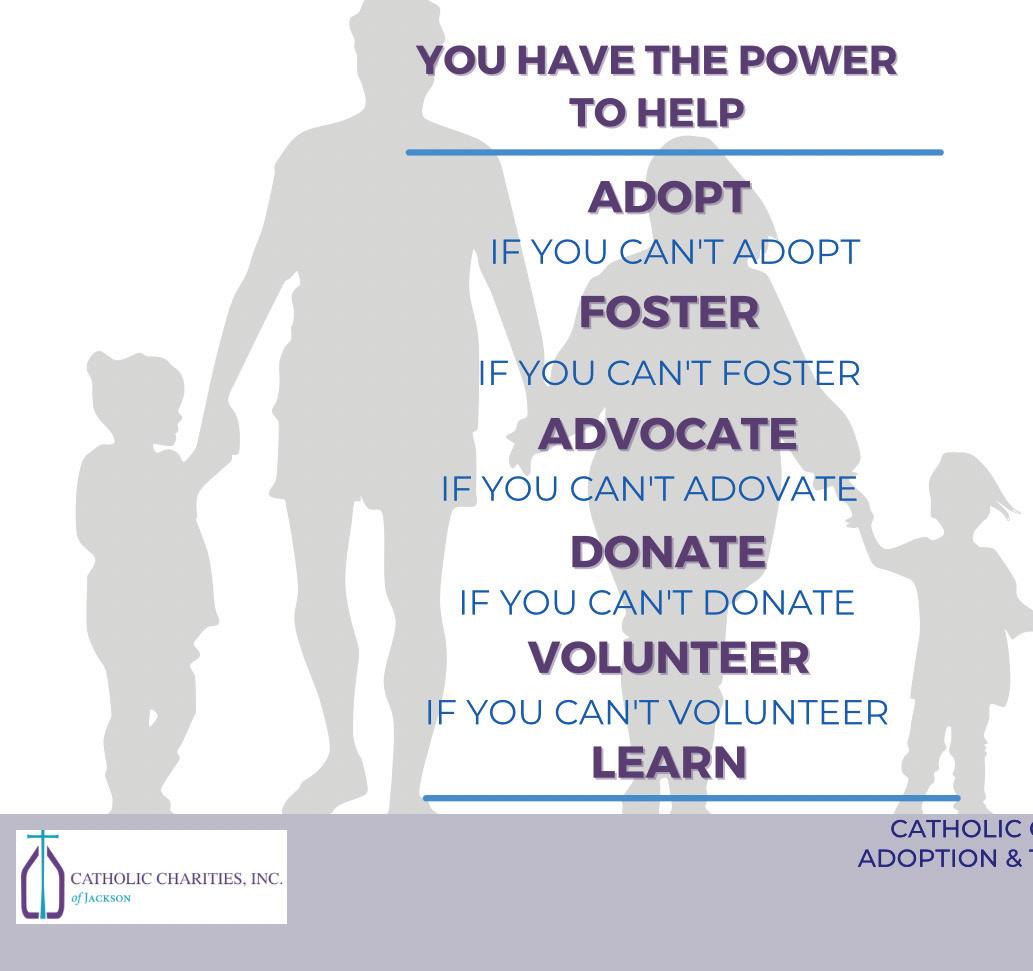
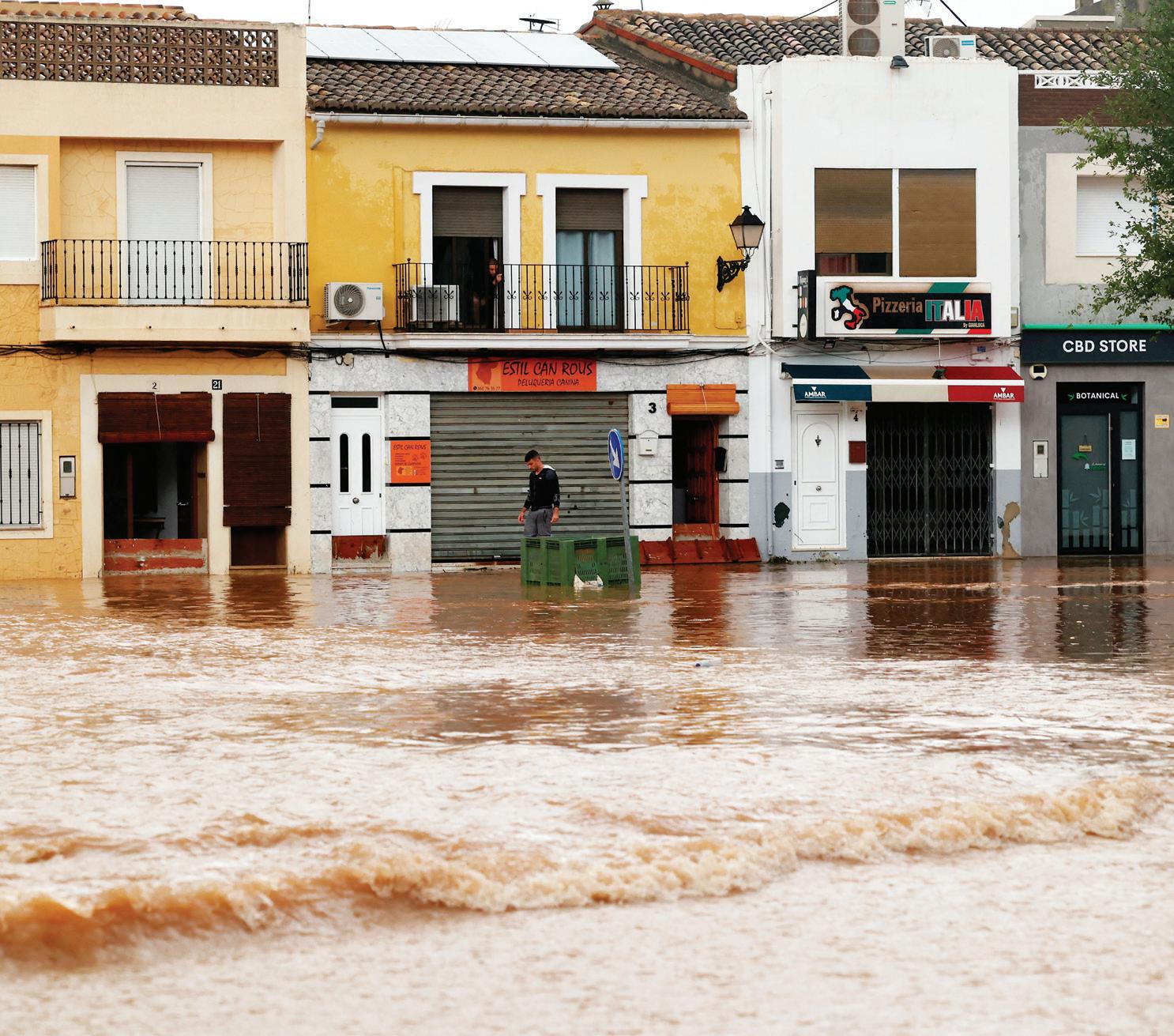
A person walks in a flooded street Oct. 30, 2024, in Llombai, in Spain’s Valencia region, after the Spanish meteorological agency put the region on the highest red alert for extreme rainfalls. (OSV News photo/Eva Manez, Reuters)
DHAKA, Bangladesh (OSV News) – Amid signs of changes and more religious inclusivity in the country, church leaders in Bangladesh called for Easter Sunday to be a public holiday. The United Church Council of Bangladesh, the Catholic bishops’ conference and Bangladesh’s Christian Association have separately demanded a public holiday from the interim government on Easter Sunday. On Oct. 17, Bangladesh’s United Church Council president, Archbishop Bejoy Nicephorus D’Cruze of Dhaka, sent a letter to the chief adviser to the interim government. After the student uprising in August that left hundreds of people dead, the country’s

prime minister, Sheikh Hasina, stepped down and fled the country to India. In his letter, Archbishop D’Cruze welcomed the interim government led by Nobel Peace Prize laureate Muhammad Yunus and said that Easter Sunday celebrates “the triumph of Lord Jesus Christ over sin and death” and is an important day for Christians. “Unfortunately, the government has not given it a (status of) holiday, despite repeated appeals to the previous government. As a result, many Christians cannot observe Easter Sunday,” the archbishop of Dhaka wrote. According to the 2022 national census by the Bangladesh Bureau of Statistics, the Muslim-majority country has about 500,000 Christians out of about 180 million, including 400,000 Catholics.told ACN. “But even if the terrorists burned everything, they didn’t burn our faith!” VALENCIA, Spain (OSV News) – The archbishop of Valencia expressed “grave concern” and said Mass for those a ected after at least 72 people died, and many more went missing amid torrential rains that caused massive flooding in southeastern Spain. The flooding turned roads into rivers of floating cars and cut o highways and access points, with water reaching the first floor of buildings. Archbishop Enrique Benavent said Oct. 30 he “hopes that the victims and missing persons will be found safe and sound as soon as possible,” according to Spanish Catholic news outlet Alfa y Omega. The archbishop celebrated Mass for all those a ected on the morning of Oct. 30 in a local basilica. In a letter sent to Archbishop Benavent and Msgr. Julián Ros, apostolic administrator of the Diocese of Albacete, West from Valencia, Spanish bishops said that they share “their pain at the di cult times that they are experiencing in their dioceses.” The horrendous flooding that left piles of cars stuck in between buildings in historical narrow streets of Valencia and trapped dozens of residents was caused by storm Dana – described as an “unprecedented phenomenon” by Spain’s defense minister, Margarita Robles. King Felipe VI spoke of his “devastation and concern” over the flash flooding. Speaking of “enormous destruction” Oct. 30, he said accessing some areas was still di cult. Spain declared three days of mourning after the flash floods devastated parts of the country.
By Mary WoodWard
Following up on the last edition’s column where we learned about the fourth bishop of the diocese, Francis Janssens, this edition will share the accounts of the bishop-elect’s ordination in Richmond, Va., and his subsequent arrival in Natchez.
Bishop Gerow’s book documenting the Janssens’ administration from 1881-1888 contains many rich details of these events so I am sharing them as gathered by him. The language is descriptive and indicative of the times which makes the actual verbiage employed a part of the experience of our collective history.
“Bishop Janssens was consecrated in St. Peter’s Cathedral at Richmond on May 1, 1881, by Archbishop James Gibbons, assisted by Bishops Becker of Wilmington and Keane of Richmond. Archbishop Elder, his predecessor in Natchez, preached the sermon. There were present also Bishops Lynch, Gross, Moore and Kain, and about fifty clergymen. Of this ceremony John Gilmary Shea says:
‘The ceremony was the grandest ecclesiastical function every seen in Richmond and attracted the largest gathering known in the history of the Church in the State.’
“After his consecration Bishop Janssens delayed little in Richmond. In his diary he says:
‘May 4th, left Richmond. Arrived 6th at Vicksburg. Was met by a delegation at Edwards. Arrived in Natchez 7th, where a great demonstration was given me.’
“The Natchez paper the next day gave an account of his arrival. He had to come down from Vicksburg on the Steamer Cannon. A committee of thirteen from Natchez had taken a tug up to Good Hope landing, where they boarded the Cannon on its way down to Natchez.
‘With Father Grignon at their head the committee repaired to the ladies’ cabin where Bishop Janssens was in waiting. Here a circle was formed about the reverend gentleman by the committee, and Capt. Jas. W. Lambert, the speaker of the occasion, addressed him in a very neat and appropriate five minutes speech.
“After explaining the motives that actuated the committee in meeting him on the boat, and the hearty welcome that awaited him at Natchez, Capt. Lambert concluded his address in the following words:
‘It is, therefore, to gratify no passing fancy, nor to confer merely ceremonial honors, that induce the faithful of your flock to come out today and deck themselves to greet you, but we come, Right Reverend Bishop, to tender you our veneration, confidence and affectionate homage, recognizing you as the apostolic successor Him Who rules both storm and wave, Who proclaimed from dark-browned Calvary’s frowning heights, ‘Peace on earth and good will to men,’ and Who holds the destinies of men and of worlds, as a grain of sand, in the hollow of His hand.
‘It is in their spirit that all come out today and we of the committee are happy indeed to be amongst the first of the city of Natchez to give you greeting and have the honor of presenting to you our congratulations, mingled with the sincere congratulations of those whom we represent. Long may you dwell with us in peace and rule with gentle sway the Holy Priests and faithful children in our good city, and throughout the Diocese of Mississippi. For ourselves, and in behalf of our people, permit us to bid you a thrice hearty welcome to our shores, our homes and our hearts.’
“When, finally, it was announced that Natchez was in sight, the Bishop hastened to the guard rail to view the city which was to be his home.
“Amid the booming of guns … at the wharf an-
other ovation awaited the Bishop. After meeting quite a number of our Catholic clergy and citizens, the carriages were announced to be in readiness, and the Bishop, attended by Fathers Grignon, Finn and Meerschaert and the various members of the reception committee, left the steamer.
“A procession was then formed at the foot of Silver street, the Bishop being seated in a carriage drawn by four horses and driven by a wellknown citizen, and the march to the Cathedral commenced, the Independent Cornet Band furnishing the music.
“Arriving at the Cathedral, Bishop Janssens and his attendants retired to the Episcopal residence, where they donned their clerical robes, and then, preceded by the acolytes, they marched up the center aisle of the church, which had been strewn with flowers, and the Bishop then took formal possession.
“Upon taking possession, Bishop Janssens addressed a few remarks to the very large assembly, after which the impressive ceremonies closed with the Benediction of the Blessed Sacrament.”

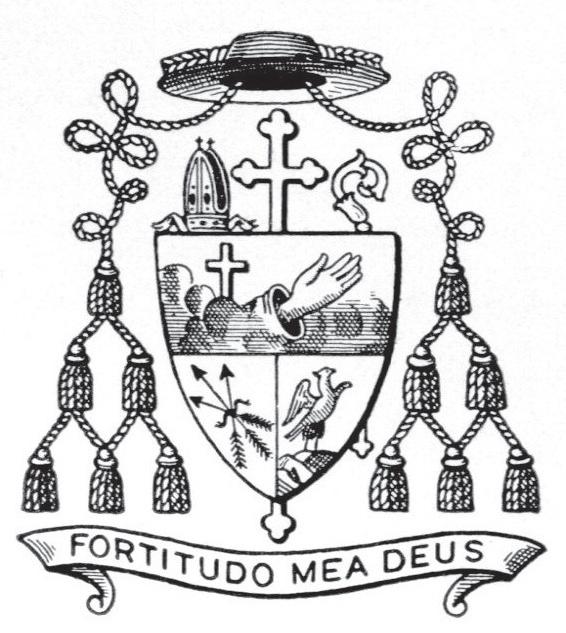
“The morning after the arrival being Sunday, St. Mary’s Cathedral was crowded.
“The Bishop ascended the pulpit after the Mass, and in an eloquent address, partaking more of an inaugural than of a sermon, expressed his pleasure at the many marks of honor, esteem and affection bestowed upon him by the people of this diocese. He was, he said, unworthy of the high ecclesiastical honors that had been bestowed upon him by his church but would endeavor in his humble way to prove worthy of them.
“The modest, unassuming and gentle demeanor of Bishop Janssens has already endeared him to Catholic hearts and his hold upon them will in time surely become second to none, not even to that of the good Bishop Elder.”
“On that same day at the evening devotions, Bishop Janssens gave Benediction of the Blessed Sacrament, and after the devotions a reception for the Bishop was held at his residence next to the church.”
Bishop Francis August Janssens was appointed fourth Bishop of Natchez in 1881 by Pope Leo XIII. He served the diocese until 1888, when he was appointed Archbishop of New Orleans. (Inset) The crest of Bishop Janssens with his motto Fortitudo Mea Deus – God is my strength. (Photos from archives)
Because of the tenure of Bishop Janssens having a very important event in the life of the diocese, namely the formal dedication of the cathedral after 46 years of building and financial struggles, I am adding a third article on Janssens’ adventures in the diocese and the long-awaited dedication of St. Mary.
(Mary Woodward is Chancellor and Archivist for the Diocese of Jackson.)

of new ‘ e Rosary in a Year’
hopes people ‘fall in love’ with the prayer
BY KATIE YODER
(OSV
News)
– A new podcast about the rosary promises to deepen listeners’ love of the Marian devotion and draw them closer to Jesus and his mother, Mary, in the new year.
“I hope people fall in love,” Father Mark-Mary Ames, a Franciscan Friar of the Renewal, the host of “The Rosary in a Year” podcast, said during a virtual press conference Oct. 28. “I hope our listeners and those who make this journey with us ... fall in love with the rosary because they experience it as ... a privileged door for encounter with Our Lord and Our Lady.”
The free podcast by Ascension, a Catholic multimedia network, begins Jan. 1, 2025, and continues through the year with a new episode released daily. Listeners can tune in on platforms including the Ascension App, Spotify and Apple Podcasts, for the episodes that run 10 to 15 minutes long. Each one will feature guidance and instruction, a prayer prompt and prayers of the rosary.
Father Mark-Mary, director of communications and director of priestly studies for the Franciscan Friars of the Renewal, said he hopes the podcast meets people where they are, from those who pray the rosary regularly to those who are beginners.
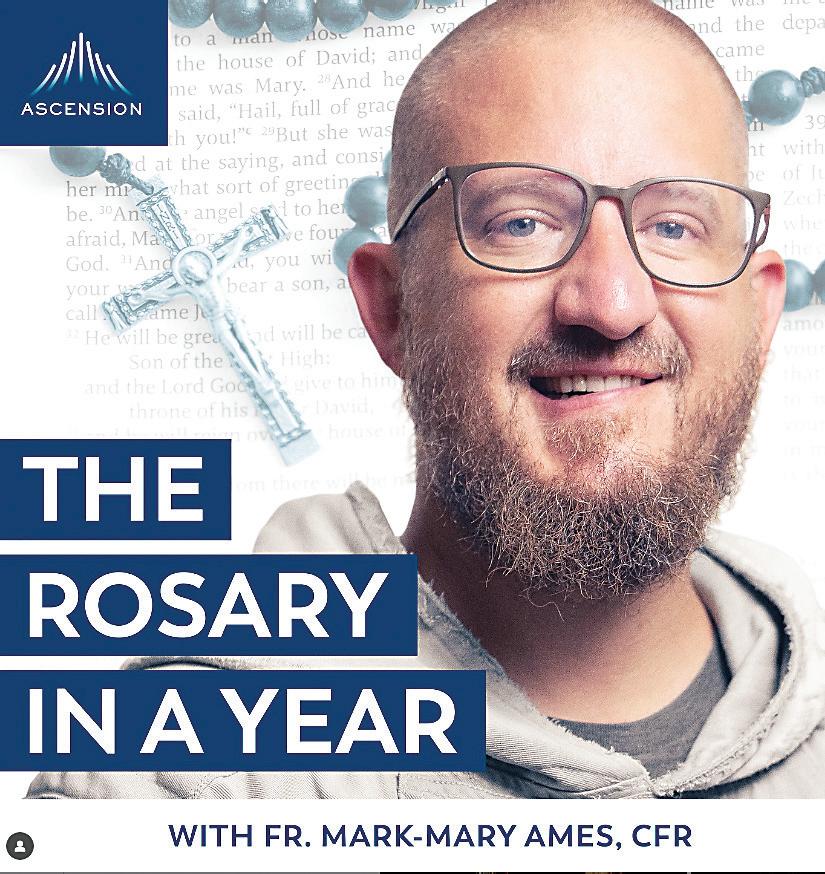
“I believe that our journey for ‘The Rosary in a Year’ is going to be learning how to – and actually being accompanied in – praying with the truths of our faith,” he said during the virtual event.
The podcast will walk with listeners through six phases of deepening prayer by starting small and gradually growing over time. It promises to help people of faith learn how to build a daily prayer habit, form relationships with Jesus and Mary, discover the biblical foundations of the rosary, realize Mary’s influence in one’s own life and meditate with sacred art, the writings of the saints and Scripture.
Listeners can follow along with the podcast by signing up online for a free prayer plan at Ascension’s website, ascensionpress.com. Other related resources are available there too, including “The Rosary in a Year Prayer Guide,” a free parish kit and a package of 50 “How to Pray a Better Rosary” booklets. Ascension also o ers rosaries inspired by the Franciscan Friars of the Renewal and their devotion to their patroness, Our Lady of Guadalupe. A new “The Rosary in a Year” YouTube channel will provide video content.
The podcast is the fourth of Ascension’s popular “In a Year” podcasts, following “The Bible in a Year,” its sister podcast in Spanish, “La Biblia en un Año,” and “The Catechism in a Year.”
Father Mike Schmitz, host of “The Bible in a Year” and “The Catechism in a Year” podcasts, will appear on bonus episodes with Father Mark-Mary.
This latest podcast comes after Father Mark-Mary did a video for Ascension in 2021 about learning to pray the rosary in a year. He has spoken about the rosary for Ascension before, including in a 2019 pray-along rosary video that went viral with more than 5 million views.
At the virtual press conference, Father Mark-Mary revealed that he struggled with the rosary as a teenager and hoped that this podcast serves as the resource he wishes he had as a young man. Pointing to St. John Paul’s II apostolic letter on the rosary, which kicked o the “Year of the Rosary” from October 2002 to October 2003, he shared how the rosary has impacted him personally.
At the end of the year, in October 2003, Father Mark-Mary was in his first semester of college and had stopped attending Mass for the first time, he said in response to a question by OSV News. Then, out of nowhere, he found himself speaking with a young woman at a dorm party who identified as an atheist.
“I said like, ‘How can you not believe?’” he remembered. “I started to defend the faith and all of a sudden like all of the lights went on. It’s like, I believe and it
needs to a ect my whole life.”
“The timing of it – it just can’t be coincidental,” he said of the event, adding that he believes that the grace of his own conversion came from all of the prayers said during the rosary year.
Today, he said, he prays the rosary every day and wears a rosary as a part of his habit.
For those who want a preview of Father Mark-Mary’s podcast, a bonus introduction episode is available.
“In a di cult world and a di cult time where it’s so easy for us to turn our attention towards everything going wrong, brothers and sisters, here is the response,” Father Mark-Mary says toward the end of that episode. “Let’s go to the Lord, let’s pray, let’s focus on him, let’s focus on the great mysteries of our salvation, let’s turn back to Our Lady, let’s remember that we have a mother who loves us, who is also powerful, who is queen of heaven and earth.”
(Katie Yoder is a contributing editor for Our Sunday Visitor magazine.)
A new podcast from Ascension –“The Rosary in Year” – promises to deepen listeners’ love of the Marian devotion hosted by Father MarkMary Ames, CFR begins Jan. 1, 2025. (Photo by Ascension)
MILWAUKEE – Sister Noel Le Claire, who lived her religious vocation in education and a wide range of pastoral care and social service ministries, died at Our Lady of Angels in Greenfield, Wisconsin, on Sept. 13, 2024. Sister Noel was 94 years old.
Sister Noel was born on Dec. 23, 1930, in Escanaba, Michigan. She was received into the School Sisters of St. Francis on June 13, 1947; made her first profession of vows on June 21, 1949; and final (perpetual) vows on June 21, 1955.
Sister is survived by her sisters, Therese (John) Remski of Canton, Michigan, and Sister Margaret Le Claire, SSSF of Milwau- kee, Wisconsin; nieces and nephews; and by the School Sisters of St. Francis community with whom she shared life for 77 years.
Beginning in 1951, Sister Noel ministered in Wisconsin, Kentucky, Illinois and Mississippi. In the Diocese of Jackson, Sister served as a social service worker at Sacred Heart Southern Missions in Holly Springs from 1992-1994 and at a Holly Springs social services agency from 1994-2005.
Sister Noel retired in 2017 and ministered through prayer and presence at Our Lady of the Angels until the time of her death.
A funeral Liturgy was held on Oct. 2 at St. Joseph Hall in Milwaukee, followed by a burial service at Mt. Olivet Cemetery in Milwaukee.
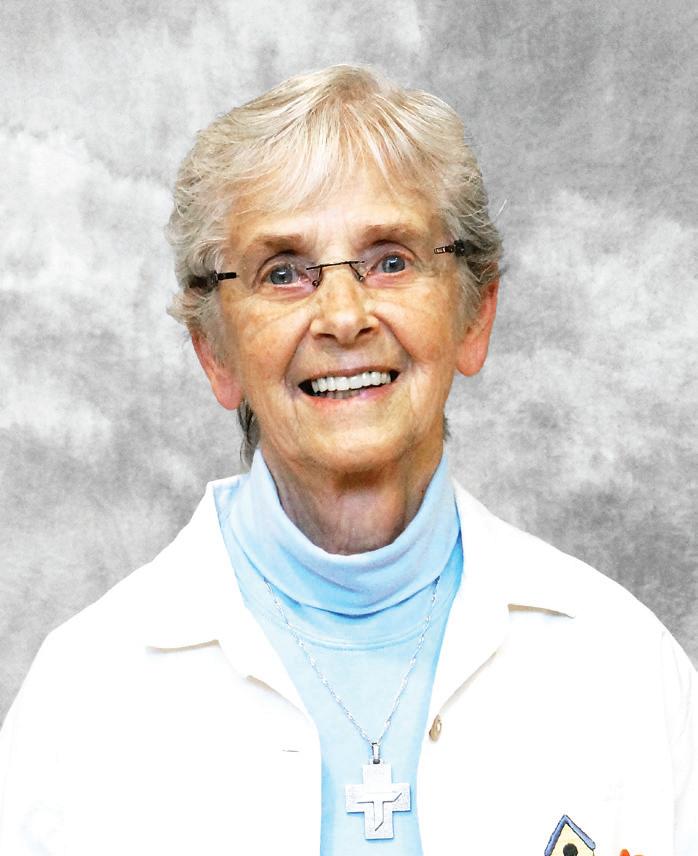
By Gina Christian (OSV News)
– Pope Francis’ new encyclical on the Sacred Heart of Jesus is being hailed as “a simple and powerful cure” for a fractured world, said the president of the U.S. Catholic bishops’ conference – and that sentiment was echoed by other experts on devotion to the Sacred Heart.
“Dilexit Nos” was released Oct. 24, following Pope Francis’ announcement in June, a month traditionally dedicated to the Sacred Heart, that he planned to issue a document about the devotion to “illuminate the path of ecclesial renewal, but also to say something significant to a world that seems to have lost its heart.”
“The ills of modern society can read like a litany of uncurable diseases: consumerism, secularism, partisanism,” said Archbishop Timothy P. Broglio, president of the U.S. Conference of Catholic Bishops, and head of the U.S. Archdiocese for the Military Services, in an Oct. 24 statement. “In his latest encyclical ... the Holy Father teaches us that devotion to the heart of Jesus can open our own hearts to renewed ways we can love and be loved.”
Heart encyclical hailed as a ‘simple and powerful cure’ to

The Sacred Heart of Jesus is depicted in a stained-glass window at Our Lady Queen of Martyrs Church in the Forest Hills section of the Queens borough of New York. (OSV News photo/Gregory A. Shemitz)
Subtitled “On the human and divine love of the heart of Jesus Christ,” the 28,000-word text – available on the Vatican’s website in Arabic, English, French, German, Italian, Polish, Portuguese and Spanish – draws on Scripture, church teaching and the writings of various saints regarding the devotion, which has a centuries-long history.
The encyclical adds to the numerous papal documents on the Sacred Heart since 1899, and is intended to complement Pope Francis’ previous two encyclicals on social teaching, “Laudato Si’: On Care for Our Common Home” and “Fratelli Tutti: On Fraternity and Social Friendship.”
“The present document can help us see that the teaching of the social encyclicals ... is not unrelated to our encounter with the love of Jesus Christ,” Pope Francis wrote. “For it is by drinking of that same love that we become capable of forging bonds of fraternity, of recognizing the dignity of each human being, and of working together to care for our common home.”
“We need this timely counsel,” Archbishop Broglio said in his statement.
“In an age where we are at each other’s throats – whether it’s simply disagreeing with positions or even going to war – appealing to the heart of not only of people, but more importantly of Christ, refocuses us on what really matters to being human,” Father Thomas Dailey, a member of the Oblates of St. Francis de Sales and author of “Behold This Heart: St. Francis de Sales and Devotion to the Sacred Heart,” told OSV News.
Timothy O’Donnell, president emeritus of Christendom College and author of “Heart of the Redeemer,” said the pope’s new encyclical “could really go a long way to help people get back to what’s really
essential in Christianity.
“Devotion to the Sacred Heart really is a summary of the whole mystery of our redemption, as Pope Pius XII and numerous other popes have said,” O’Donnell told OSV News. “And if anything, that call ... is even more urgent now in our current times, with the loneliness, the isolation, the sort of secular miasma that we all have to breathe, where oftentimes we are affected far more by this atmosphere of secularity, (rather) than drawing from the riches of a relationship with Christ.
And it is Christ, O’Donnell said, “who brings love to a world that really is starving for it.”
The timing of the document is “intentional,” added Father Dailey, who is the chair of homiletics and social communications, as well as project director of the Catholic Preaching Institute, at St. Charles Borromeo Seminary in Ambler, Pennsylvania.
He stressed the need to approach others not in terms of “policy to policy, war to war, or nationality to nationality,” but “heart to heart,” since “the heart is what makes us the same.”
The encyclical stands to call attention to “the personhood and the importance of the uniqueness of each individual,” said Father Donald Callo-
way, a member of the Marians of the Immaculate Conception and author of numerous books, including “Sacred Heart Gems: Daily Wisdom on the Heart of Jesus.”
Father Calloway said that in his initial perusal of the encyclical he was struck by the document’s emphasis on “an aspect of being” that is often neglected in current society.
“Being devoted to the heart is being devoted to the person,” he told OSV News. “I think it’s time to get back to some of these fundamentals. We live in this robotic, technological age where, I think, we’re forgetting that things have consequences. You can be on social media and you crank out a post, not realizing that you’re actually hurting people. You’re hurting hearts, not just some robot or some machine. ... It affects people.”
He also stressed the need to attend to “the heart of our God.”
“There’s so much going on in the world right now that I think is offending our Lord’s heart,” Father Calloway said.
“It’s a good time to be reminded of the heart of our God, and that he loves us and wants us even to console him, to make reparation to him for our own sins and the sins of others,” he said.
“Jesus has a heart just like you and I do,” Father Dailey emphasized. “That heart loves just as yours and mine does. That heart breaks; that heart, poured out in love for humanity, is the ultimate sign of God’s love for human beings.”
(Gina Christian is a national reporter for OSV News. Follow her on X, formerly Twitter, @GinaJesseReina.)
The Diocese of Jackson has launched a third-party reporting system that will enable all diocesan employees, volunteers and parishioners to anonymously (or named if preferred) make reports. Examples of this activity include fraud, misconduct, safety violations, harassment or substance abuse occurring at a Catholic parish, Catholic school or at the diocesan level. The system is operated by Lighthouse Services.
To make a report visit www.lighthouse-services.com/ jacksondiocese or call 888-830-0004 (English) or 800-216-1288 (Spanish).
The Association of Priests of the Dioceses of Jackson and Biloxi provide a small pension to our retired priests. As you consider your estate plans, please remember these faithful servants by making a donation or leaving a bequest to the Association of Priests. Our parish priests dedicate their lives to caring for us, their flocks. Let us now care for them in their retirement. Donations can be made payable to the Association of Priests and can be mailed to: Diocese of Jackson, P.O. Box 22723, Jackson, MS 39225-2723
By Laura Grisham
HERNANDO – Our local School Sisters of St. Francis recently celebrated the 150th anniversary of their religious order with a Mass and dinner at Holy Spirit Church in Hernando, Mississippi. Fittingly, the event took place on the day of the Feast of St. Francis of Assisi. Northern Mississippi’s four School Sisters of St. Francis – Sisters Margaret Sue Broker, Ramona Schmidtknecht, Julene Stromberg and Rose Hacker – were joined by their U.S. Provincial, Sister Kathleen O’Brien, ten local Associates, and numerous parishioners from six area parishes. The Most Reverend Joseph Kopacz served as the main celebrant, with Mississippi SCJs as concelebrants.
The School Sisters of St. Francis was founded in 1874 by Emma Hoell (Mother Alexia), Paulina Schmid (Mother Alfons) and Helena Seiter (Sister Clara), who traveled from Germany to establish the order in Wisconsin. Over the years, the Sisters have expanded their ministries globally, reaching countries such as Honduras, Peru, India, Nicaragua, Mexico, Guatemala, Costa Rica, and more recently, Tanzania.
In his homily, Bishop Kopacz honored the courage of the order’s founders, reflecting on their desire to assist immigrants and create a robust religious community to address the church’s needs. “One year after the Sisters of St. Francis began their migration to this country, the church dedicated the World Day of Migrants and Refugees,” Bishop Kopacz noted. He also highlighted the Sisters’ work in Mississippi, dating back to the 1940s in Yazoo City and later in Walls and Holly Springs, where they were invited to educate and help care for the poor by the Priests of the Sacred Heart.
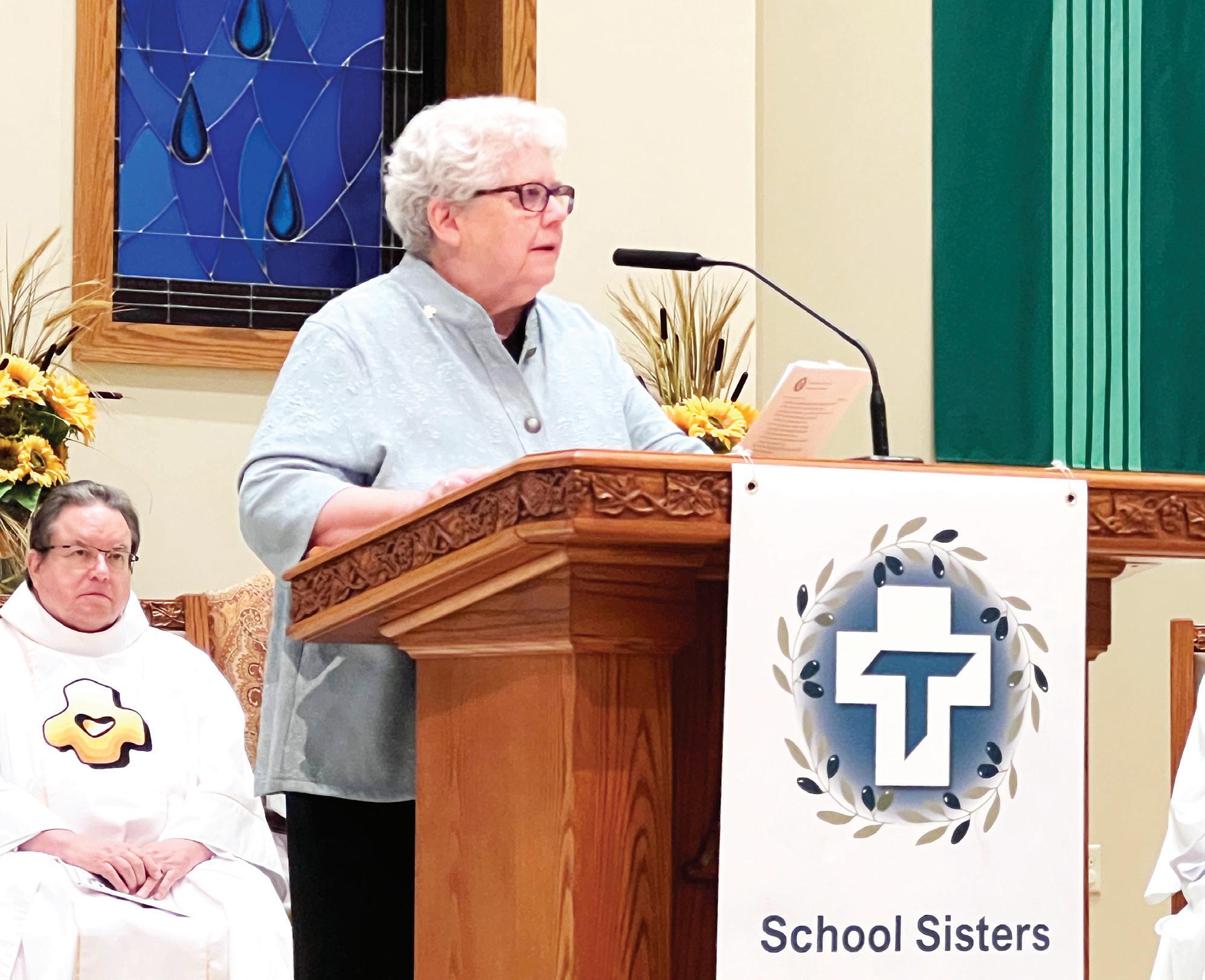
Drawing from the life of St. Francis, Bishop Kopacz described how the Sisters’ mission reflects his vision of compassionate service. Referencing Pope Francis’ emphasis on tenderness, the bishop remarked that St. Francis was “the original ecologist,” deeply connected to both creation and the cross. He commended the Sisters’ continued dedication, stating, “Every day requires the courage to live and proclaim the Gospel.”
HERNANDO – Sister Kathleen O’Brien, OSF addressed those in attendance at the 150th anniversary celebration of the School Sisters of St. Francis about the order’s modest beginnings and praised Sacred Heart School as a “wonderful place and expression” of the Sisters’ mission. (Photo by Laura Grisham)
Sister Kathleen O’Brien, OSF, addressed the gathering, describing the order’s
modest beginnings and the vision of the three founders, which grew into a global community. “They came from Germany, stopping in Philadelphia, Chicago, and Milwaukee, eventually founding their order in a small town in Wisconsin 150 years ago.” She invited all in attendance to view a display of flags representing the Sisters’ worldwide reach.

Reflecting on her first visit to Mississippi, Sister Kathleen praised Sacred Heart School as “a wonderful place and expression” of the Sisters’ mission. She emphasized the importance of collaboration, saying, “We consider you partners and collaborators in God’s mission … we are all participants, ensuring this is a community of love and care.” She commended Sisters Broker, Schmidtknecht, Stromberg and Hacker, who together have served 178 years in Mississippi.
In appreciation of the Sisters’ work across northern Mississippi, the Queen of Peace Church Women’s Club presented a $1,000 donation, expressing hope that the Sisters would “continue their mission of witnessing to God’s love and being a source of hope.” The evening concluded with a blessing over the meal, thanking God for the community gathered to celebrate this milestone and for the bounty of creation.
The congregation has a rich history, with Mother Alexia extending the Sisters’ ministries across Europe in the late 19th century. Under the leadership of Mother Alfons, known for her love of the arts, the community developed a strong tradition in music and liturgical arts. This legacy of artistic excellence and leadership continues to shape their ministries. Since their founding on April 28, 1874, the Sisters have devoted themselves to Christ’s mission through nursing, teaching, social work, and pastoral ministry, addressing the needs of their time with enthusiasm and commitment.
(Laura Grisham is the PR and Communications manager for Sacred Heart Southern Missions in Walls, Mississippi.)
By Melvin Arrington
Why is the life of a saint who died more than 1,600 years ago relevant to us today? In other words, why does St. Martin of Tours (315 to 397) still matter?
The short answer is because his was a life well lived. There is much we can learn from him about respecting the dignity of each person and about practicing the church’s preferential option for the poor.
Born into a pagan family in present-day Hungary and raised in what is now Italy, Martin enrolled as a catechumen at a tender age. His father, an officer in the Imperial Roman army, wanted his son to pursue a military career, but Martin had no interest in becoming a soldier. Nevertheless, he was conscripted into the army. At age eighteen he was baptized. Two years later he left the military, proclaiming: “I am a soldier of Christ; it is not lawful for me to fight.”
Interestingly, Martin’s feast day, Nov. 11, is also Veterans Day, which honors all who have served in the military and, additionally, commemorates the signing of the Armistice that ended fighting in World War I.
After leaving the army, Martin met Hilary, Bishop of Poitier, who encouraged the young man to return to Italy to try to win over his family and friends to the Christian faith. But upon arriving there he found himself surrounded by followers of the Arian heresy. After struggling to convert the Arians, Martin returned to Gaul (France) and established a monastery near Poitiers, where he gathered a group of followers and began preaching throughout the area. Because of his holiness, asceticism, and reputation as a miracle worker, the people elected him Bishop of Tours.
Martin founded many churches and monasteries and became a strong defender of the faith, fighting pagans and heretics with words rather than the sword. Known for his compassion, he became an early opponent of the death penalty and often pled for mercy on behalf of those condemned to death.
Because of Martin’s renown as a healer, people with various diseases and disorders came to him seeking cures, among them a leper, a paralytic, and a woman with an issue of blood. He also drove out evil spirits from the demon possessed and raised the dead. Those in the latter category included a man who had died without baptism, another who had hanged himself, and a third man, whose resuscitation resulted in the conversion a large crowd of pagans who had witnessed the miracle. Once, when a pagan attempted to behead him, the sword separated itself from the would-be assassin’s hand and fell harmlessly to the ground.
The most memorable incident in this great saint’s life occurred in the city of Amiens during his stint in the army. On a cold winter’s day as Martin was riding through the gate leaving the city, he encountered a practically naked beggar who was freezing from the cold. Deeply moved by the poor man’s suffering, the young soldier took his sword in hand, cut his cloak in two, and gave half to the poor stranger. That night Martin experienced a vision of Christ clothed in the

portion of the cloak he had given to the beggar.
This great act of charity, immortalized in El Greco’s painting “St. Martin and the Beggar” and Van Dyck’s “St. Martin Dividing His Cloak,” brings to mind the admonition: “Whoever has two tunics should share with the person who has none.” (Luke 3:11) St. Ambrose, a contemporary of St. Martin, expressed it this way: “If you have two shirts in your closet, one belongs to you and the other to the man with no shirt.”
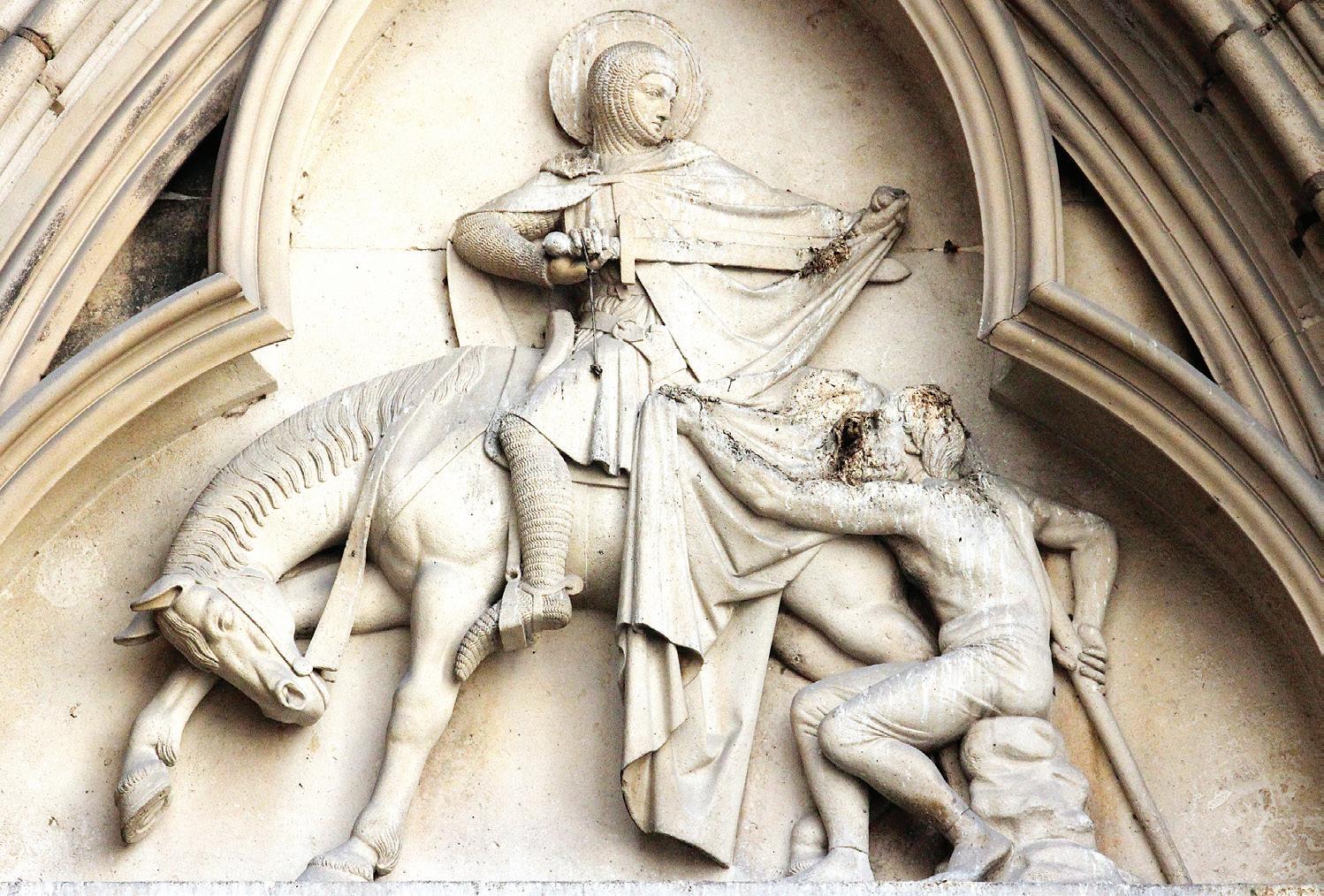
PARIS – St. Martin of Tours, tympanum of St. Severin Church. The Church is one of the oldest on the Left Bank situated in the Latin Quarter. (Photo courtesy of BigStock)
I like to think St. Martin had so internalized the teachings of Matthew 25 that he helped the beggar because charity was second nature to him. In Matthew 25:34-40 Jesus tells the blessed they will inherit the kingdom because they came to his aid when He was in need; among other things, He was naked and they clothed Him. These righteous ones, not realizing what Jesus meant, question Him about it, implying that they really didn’t do anything at all for their Lord. Then the King of Kings replies: “Amen, I say to you, whatever you did for one of these least brothers of mine, you did for me.”
How should we respond to the plight of the poor? Of course, we should pray for them, but that’s not enough. We must put our faith in action by performing the corporal works of mercy. Specifically, we are called to feed the hungry, give drink to the thirsty, welcome the stranger, clothe the naked, care for the sick, and visit the prisoner. This is what St. Paul meant by “faith working through love.” (Galatians 5:6b)
With so many needs and so many opportunities for giving of our time and resources, it shouldn’t be hard to find ways to follow St. Martin’s example. Contributing to relief efforts for those attempting to put their lives back together in the wake of the recent hurricanes is just one way. If we open our eyes and ears, the needs in our local communities will become readily apparent to us.
St. Martin of Tours, the soldier who didn’t want to fight, was one of the first holy persons to become a saint without
being martyred. His abiding concern for the poor, the sick, and the imprisoned made him a model of compassion for his generation and an inspiration to Christians across the centuries. May this “soldier of Christ” inspire in us a fervent desire to become models of “faith working through love.”
(Melvin Arrington is a Professor Emeritus of Modern Languages for the University of Mississippi and a member of St. John Oxford.)

By Tereza Ma and Joanna King GREENVILLE – Thanks
to the generosity of Salvador Sarullo, student-athletes at St. Joseph School now enjoy upgraded athletic facilities. The school celebrated the grand opening of its new athletic complex with a special Mass and ribbon-cutting ceremony on Wednesday, Oct. 16.
Bishop Joseph Kopacz led a blessing for the facility, which adds over 4,700 square feet to the guy and includes new, expanded locker rooms for boys’ and girls’ basketball, soccer, baseball and softball teams. The complex also features dedicated training and recovery room to help athletes stay healthy and perform at their best.
St. Joseph Church has worked tirelessly to honor Sarullo’s legacy, using his substantial donation to support the school and parish, while embarking on projects that uplift the Greenville community.
Principal Craig Mandolini expressed gratitude, saying, “We are very fortunate for Mr. Sarullo’s generosity to help out the parish and the school. In addition to the new upgrades, we’ve gotten a lot of new things for the school to benefit our students’ minds and bodies. … We are

GREENVILLE – St. Joseph School held a ribbon cutting on Wednesday, Oct. 16 for their new athletic upgrades. Pictured (l-r): Britt Virden, Carl McGee (president of the Washington County Board of Supervisors), Bishop Joseph Kopacz, Principal Craig Mandolini and Mayor Errick D. Simmons. (Photo by Tereza Ma)
so honored to receive the gift that we have been given.”
Phil Mansour, director of the St. Joseph School Athletic Association, said that the athletic complex project and other upgrades have been needed for years. He also said that the upgrades allow for the school to host state and district basketball tournaments.
“In addition to Mr. Sarullo, I thank Bishop Kopacz for his dedication and commitment to this school, said Mansour.
He also thanked architect Joseph Orr for working within a tight budget of $1.3 mission, a difficult feat given today’s construction cost. “He did a wonderful job, and we are so proud of the facility,” said Mansour.
Greenville Mayor Errick Simmons also spoke at the dedication and ribbon cutting ceremony, expressing gratitude on behalf of the city: “We thank the bishop, faculty, and parents of St. Joseph for this wonderful facility based in God. When you think about economic development and you think about merging recreation, education and community development, I think St. Joe has done a really good job.”
By Karla luKe
The Catholic Schools and Early Learning Centers in the Diocese of Jackson are eagerly gearing up for the renewal of their accreditation with Cognia, an esteemed accrediting body for K-12 institutions in the U.S. and globally. Since 2019, the Office of Catholic Education (OCE) has held system-wide accreditation for all Catholic schools within the diocese, a commitment that has prompted notable growth and advancements across the system. Now, as renewal approaches, school leaders are ready to showcase their developments in educational excellence and student-centered progress.
Cognia’s legacy of accreditation excellence Cognia, formerly known as AdvancED, is a nonprofit that accredits schools with a focus on continuous improvement. Founded in 2006, Cognia brought together the pre-college divisions of two major accreditation groups: the North Central Association’s Commission on Accreditation and School Improvement (NCA CASI) and the Southern Association of Colleges and Schools Commission on Accreditation and School Improvement (SACS CASI). Following further expansions, including a merger with Measured Progress in 2018, Cognia emerged as a leading accrediting agency recognized by the U.S. Department of Education in 2019.
The Diocese of Jackson’s journey with Cognia builds upon a longstanding relationship with its predecessor, SACS CASI. Since 1975, schools like Vicksburg Catholic Schools, St. Joseph Madison, and Cathedral Natchez have held SACS accreditation. By 2020, all remaining schools in the diocese had secured full system accreditation, further solidifying their commitment to academic and spiritual growth. Why Cognia? Focusing on Systemic Growth Over Compliance
Choosing Cognia for system-wide accreditation allows the diocese to emphasize continuous improvement, focusing not just on meeting standards but on showing how those standards drive real change. Unlike some accrediting bodies that prioritize compliance, Cognia’s approach is student-centered, emphasizing learning engagement, school culture, student development, and strong leadership that fosters a culture of achievement. Cognia’s platform also equips the OCE with tools like professional development resources, assessments and strategic planning aids that are crucial for making well-informed decisions.
The renewal process for Cognia accreditation involves in-depth reviews in seven essential areas: Culture of Learning, Leadership for Learning, Engagement in Learning, Student Growth, Student Performance, Stakeholder Analysis, and Learning Environment. The OCE Accreditation Leadership Team – led by Karla Luke (OCE), Dr. Dena Kinsey (St. Joseph-Madison), Mary Arledge (Vicksburg Catholic Schools), Kimberly Burkley (Cathedral Catholic School), Rachel Patterson (OCE) and Virginia Hollingsworth (OCE) – recently presented on Oct. 15, a detailed executive summary to Dr. Michael Bratcher, Cognia’s regional accreditation advisor, outlining the diocese’s mission, vision, values and accomplishments.
Since the initial accreditation, the diocese has launched numerous initiatives, including a three-year strategic plan, enhanced academic standards, strengthened assessment programming, and the opening of two new early learning centers in Vicksburg (Sisters of Mercy) and Jackson (St. Richard). Feedback gathered from focus groups held on Oct. 22 and 24, highlighted both achievements, such as improved Catholic identity,
responsive teaching practices, and communication improvements, and areas for growth, like expanded parent education and ongoing opportunities for feedback.
Continuing a tradition of faith and excellence
As the Diocese of Jackson moves forward in its accreditation renewal, the commitment to fostering a Christ-centered, academically excellent environment remains unwavering. Through the dedication of faculty, staff and administrators, the OCE is assisting by cultivating lifelong learners, effective communicators, and collaborative contributors to society, all rooted in their faith.
Blessings in faith, hope and love.
(Karla Luke is the executive director of Catholic Schools for the Diocese of Jackson)

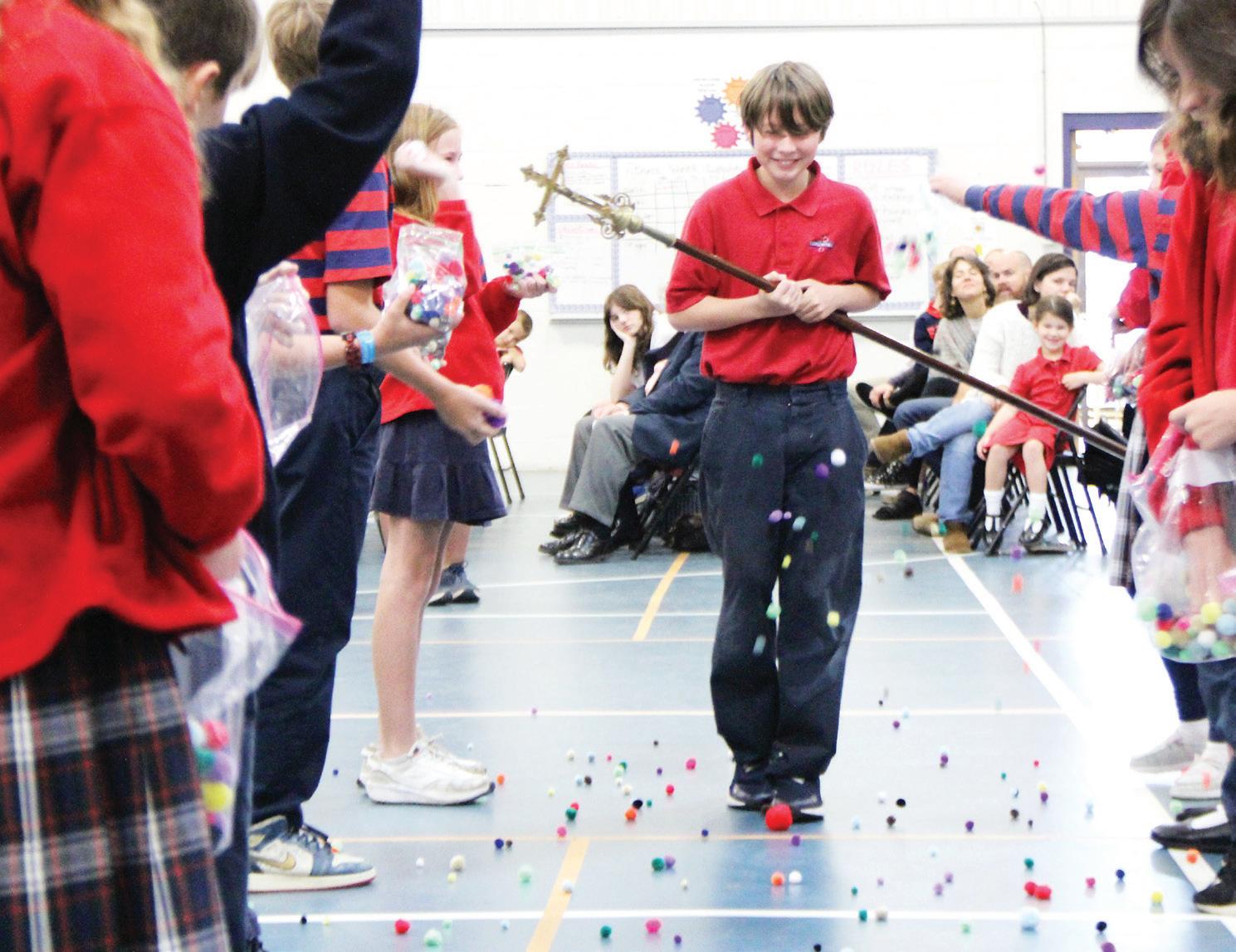
– Fifth grade students walk through a line during Mass to receive “puff ball blessings” – an example of how God blesses us even if we have a cross to bear.


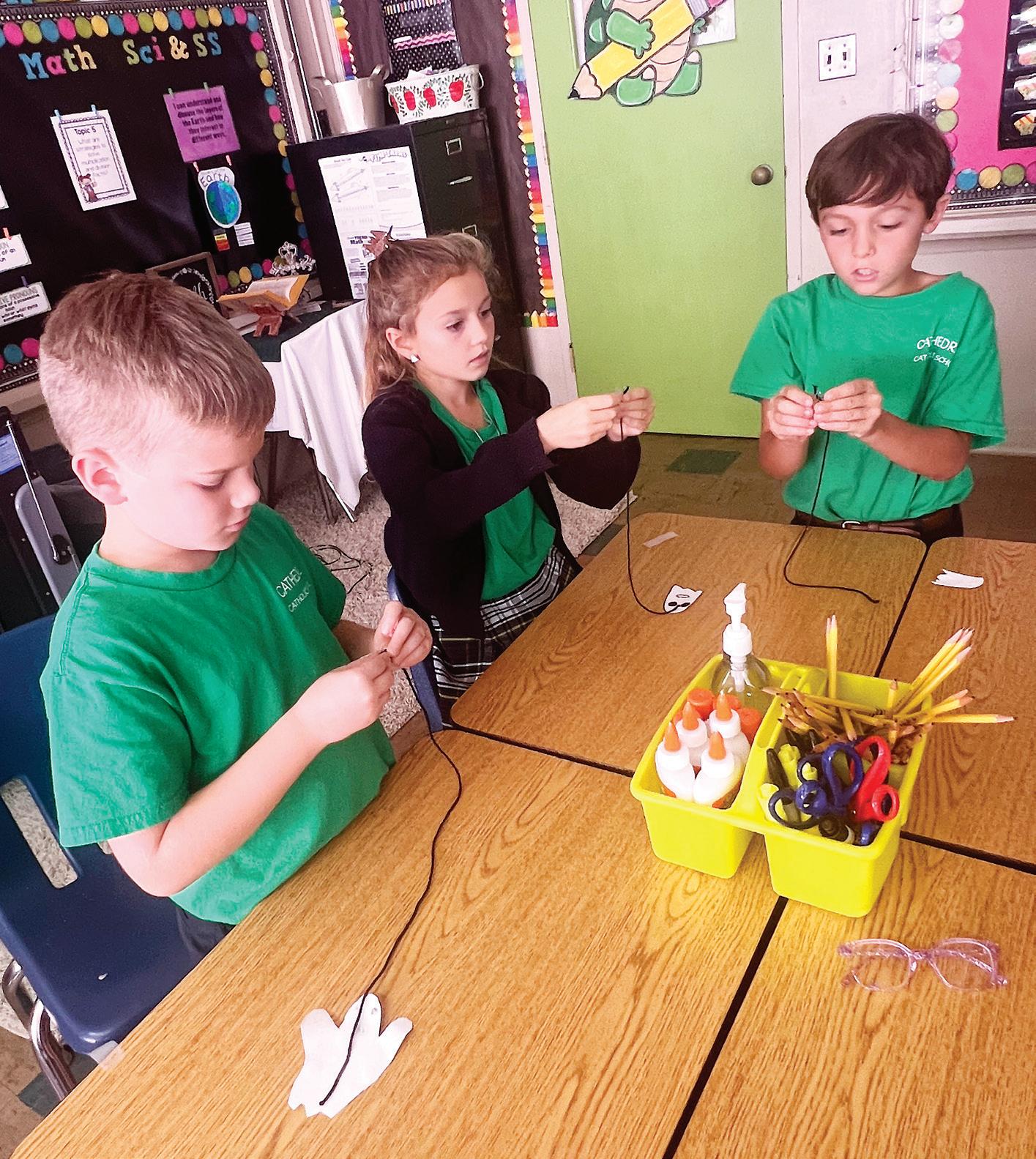
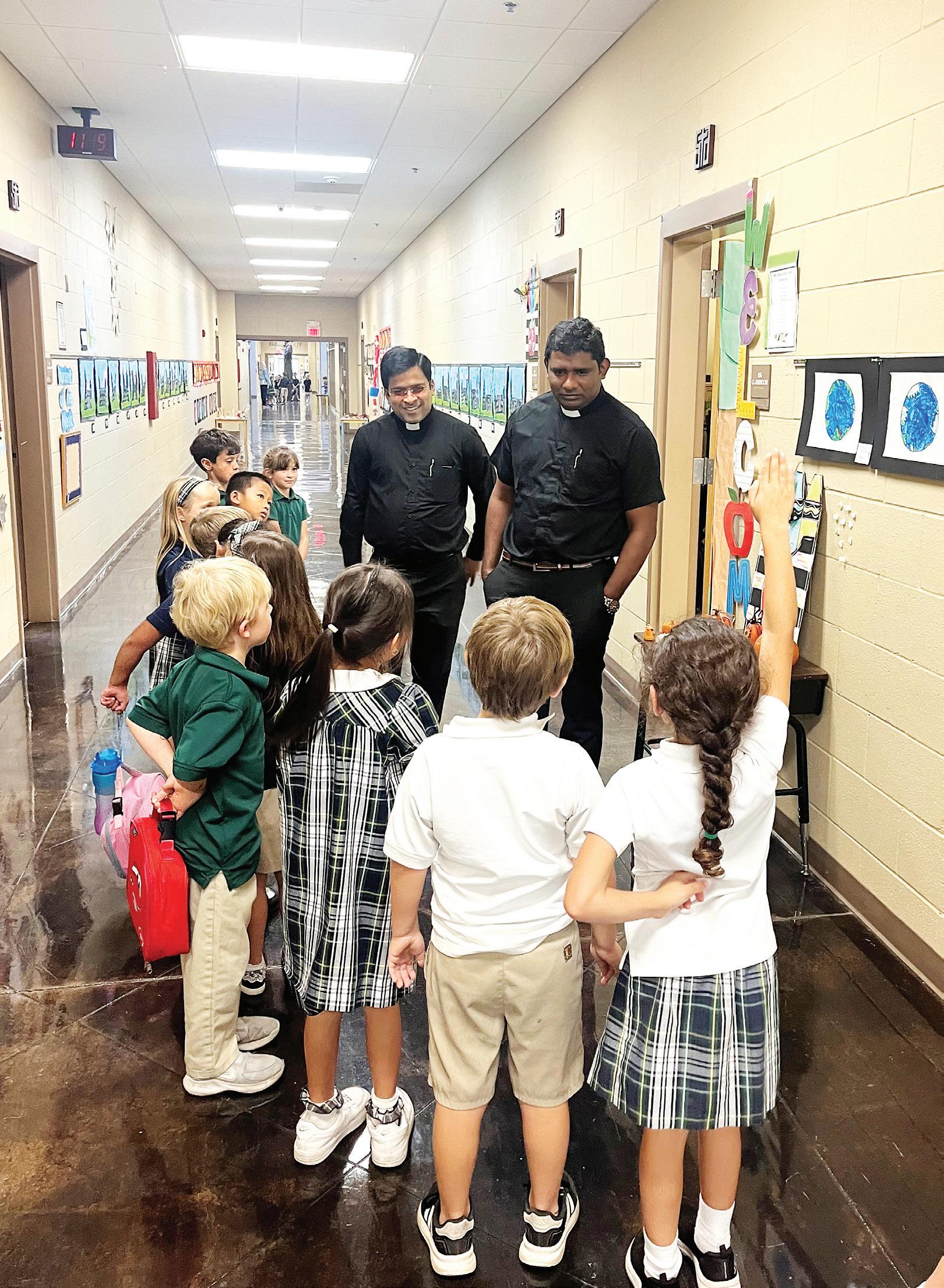
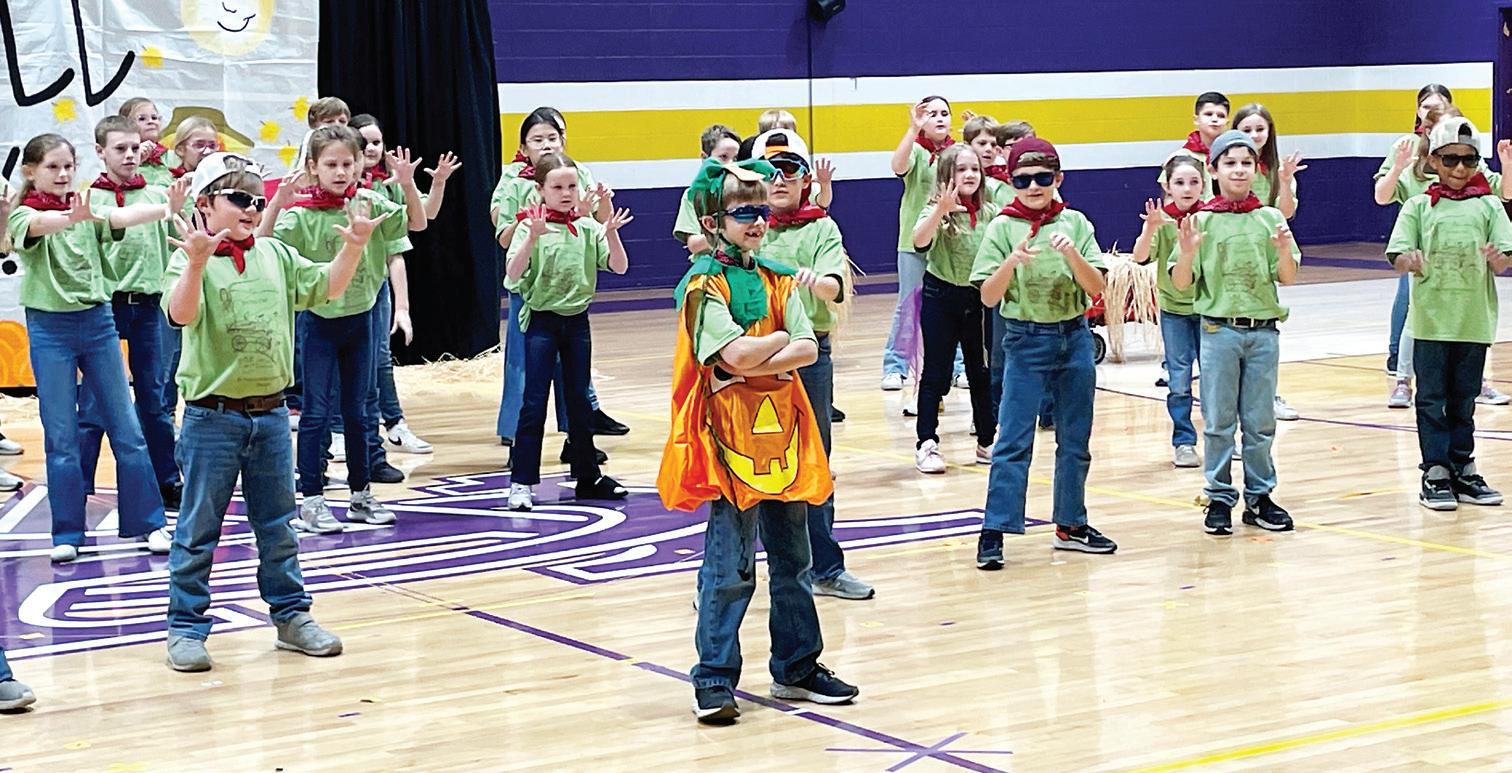
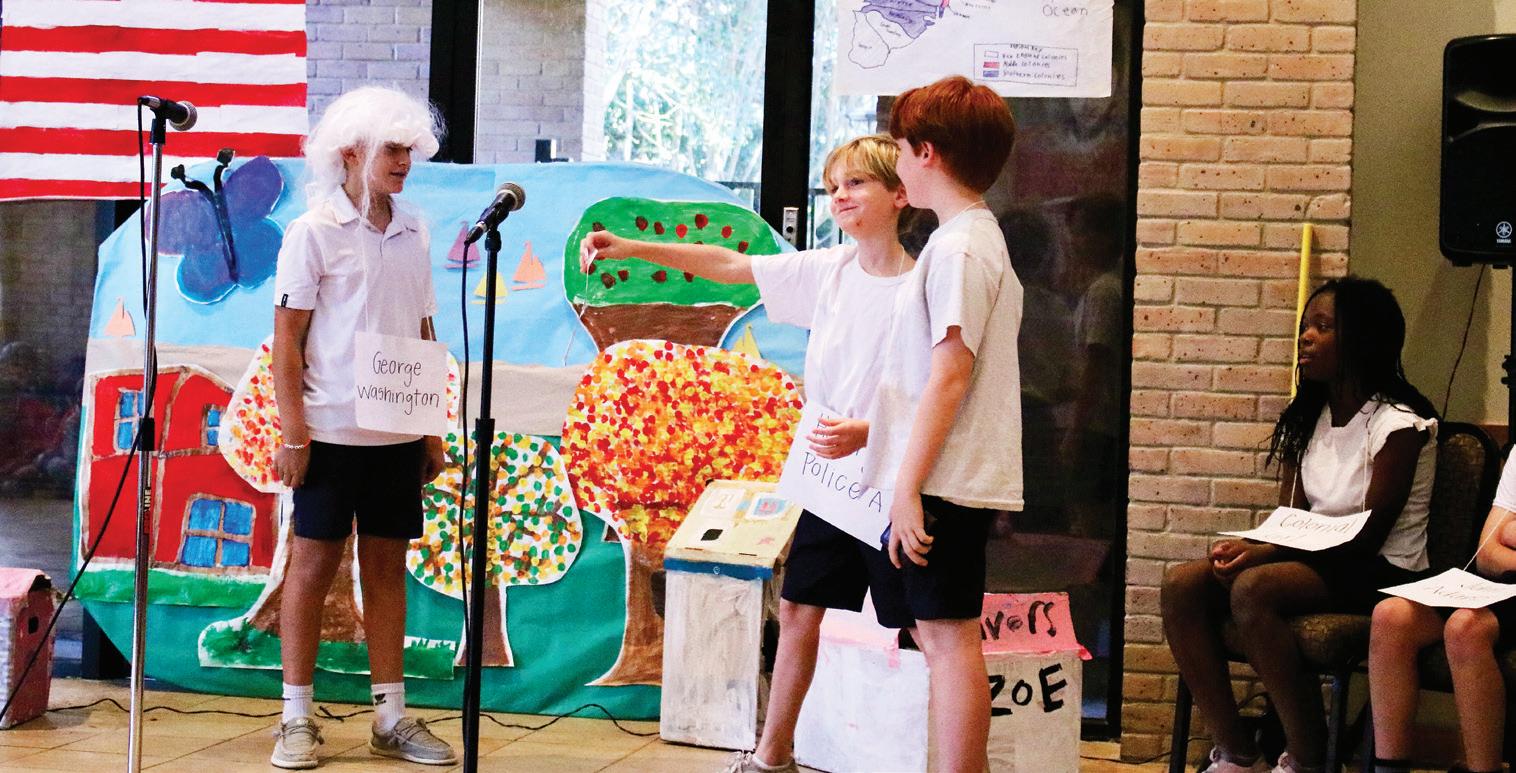




fives
as part

St. Elizabeth – Clarksdale 150 Florence Avenue Clarksdale, MS 38614 seseagles.com
Now Enrolling! Call (662) 624-4239 to schedule a tour!



Sister ea Bowman – Jackson 1217 Hattiesburg Street Jackson, MS 39209 theabowmanschool.com
Now Enrolling! Call (601) 352-5441 to schedule a tour!


St. Patrick – Meridian
2700 Davis Street Meridian, MS 39301 stpatrickcatholicschool.org
Now Enrolling! Call (601) 482-6044 to schedule a tour!


Annunciation – Columbus
223 North Browder Street Columbus, MS 39702 annunciationcatholicschool.org


St. Joseph – Greenville 1501 VFW Road Greenville, MS 38701 stjoeirish.org
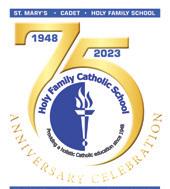
Holy Family – Holly Springs
395 N West Street Holly Springs, MS 38635 hfamilyschool.org

Open House Nov. 14 from 9:45 a.m. to 12 p.m. w/ optional 8:30 a.m. Mass; Little Eagles Preview at 6 p.m. for PreK through K.

St. Richard – Jackson
100 Holly Drive Jackson, MS 39206 strichardschool.org
Now Enrolling! Call (601) 366-1157 to schedule a tour!


Cathedral School – Natchez
701 N Martin Luther King Jr. Street Natchez, MS 39120 cathedralgreenwave.com
Now Enrolling! Call (601) 445-9844 to schedule a tour!

Now Enrolling! Call (662) 378-9711 to schedule a tour!


Now Enrolling! Call (662) 252-1612 to schedule a tour!

St. Anthony – Madison
1585 Old Mannsdale Rd Madison, MS 39110 stanthonyeagles.org
Open House Nov. 19 and 21 with tours beginning at 10 a.m.


Sacred Heart – Southaven 5150 Tchulahoma Road Southaven, MS 38671 sheartschool.org
Inspiring Minds and Igniting Hearts! Call (662) 249-0900 to schedule a tour!


St. Joseph – Madison 308 New Mannsdale Rd Madison, MS 39110 stjoebruins.com
Open House Nov. 14 from 11 a.m. to 1 p.m. and 4-6 p.m. RSVP through QR code.


Vicksburg Catholic School
1900 Grove Street Vicksburg, MS 39183 vicksburgcatholic.org
Visit our website or scan the QR code to schedule your visit!
